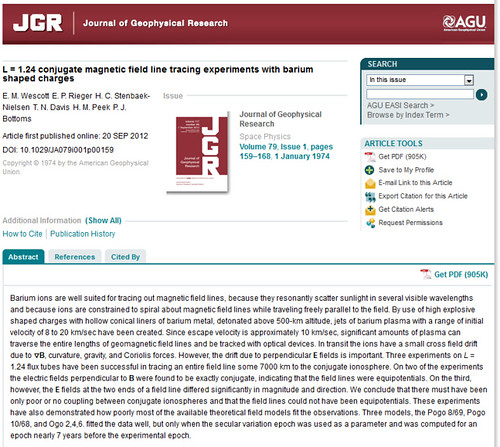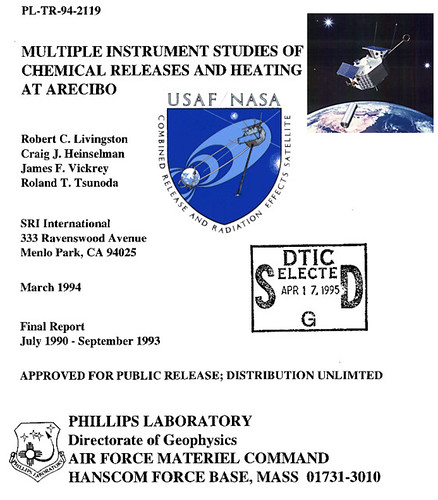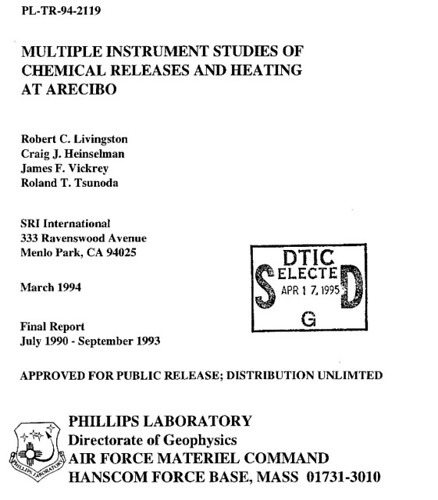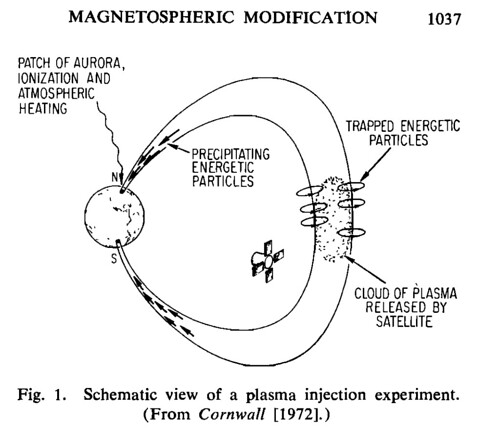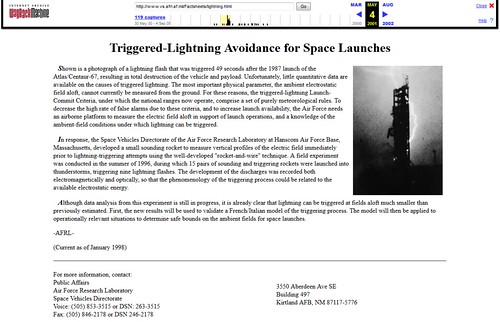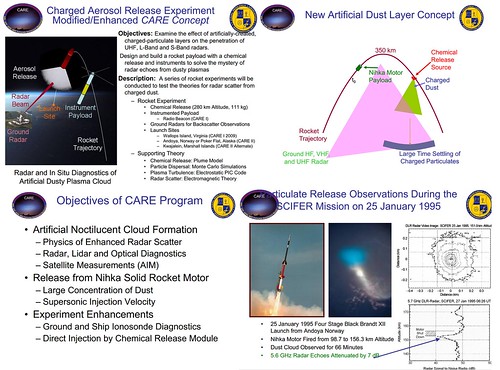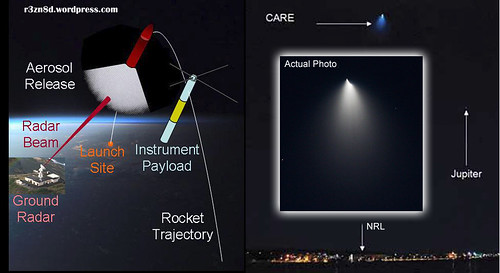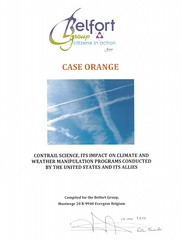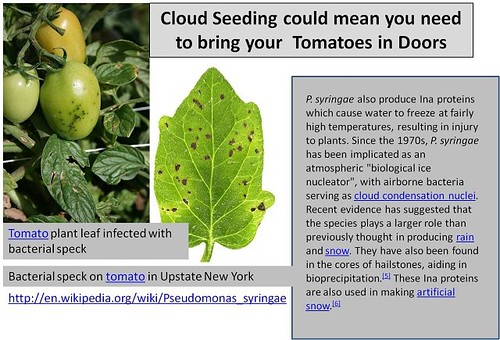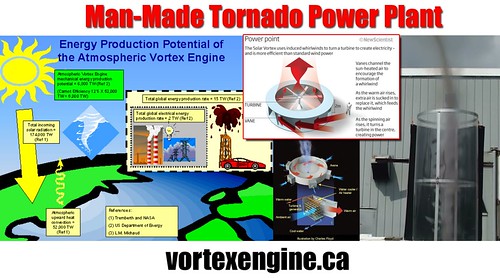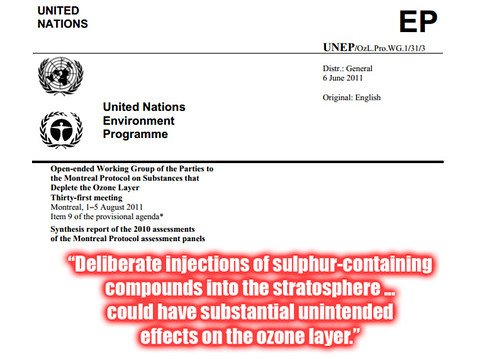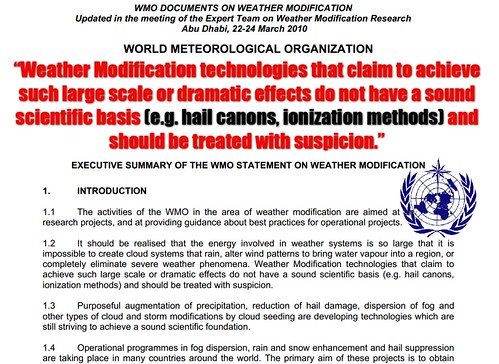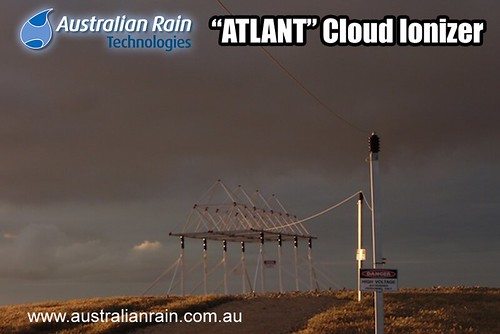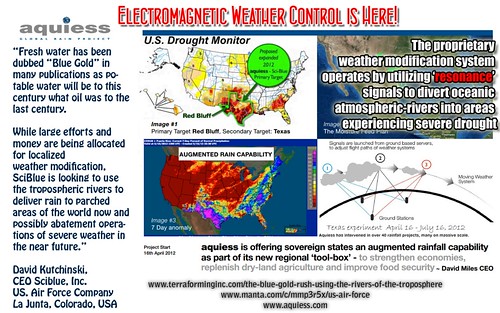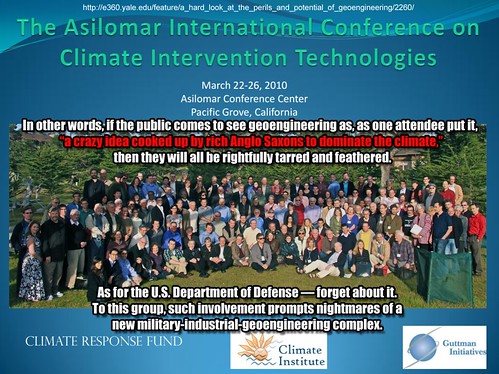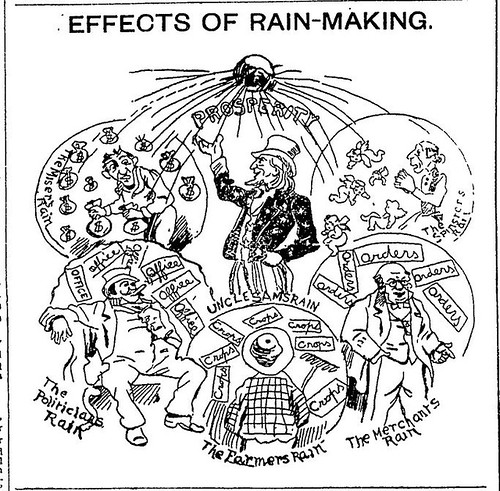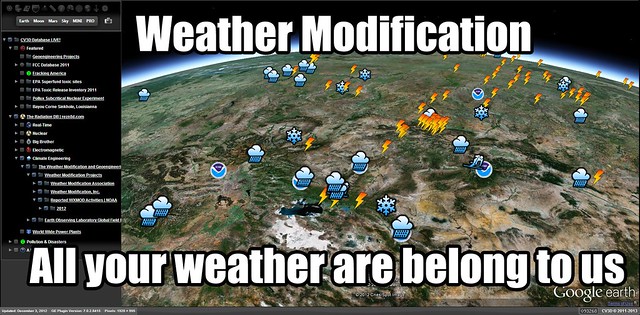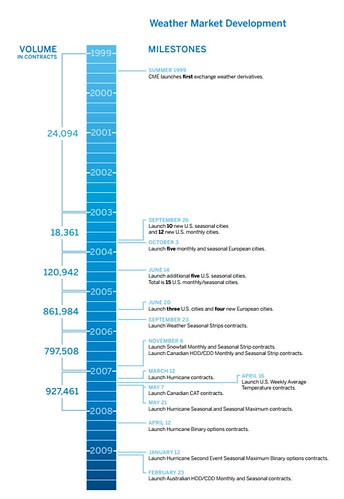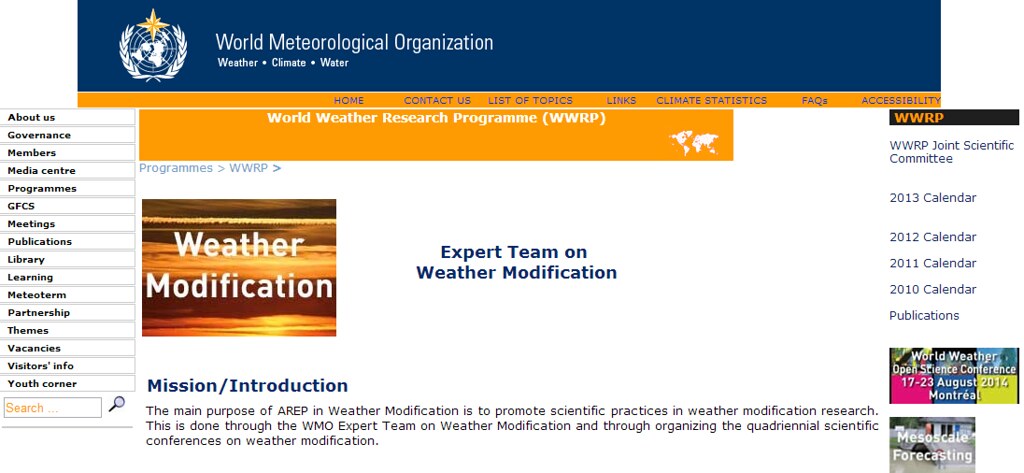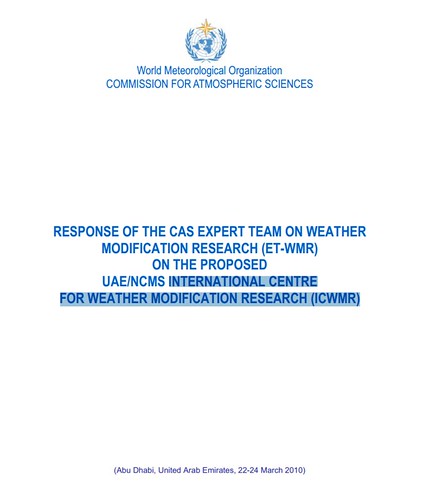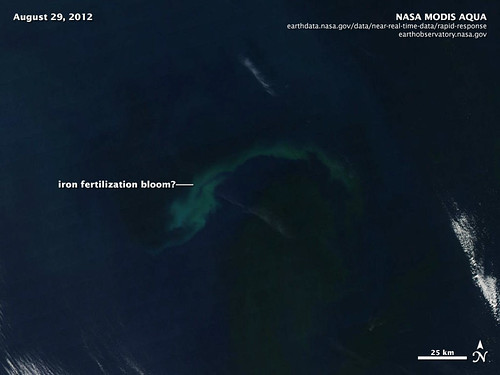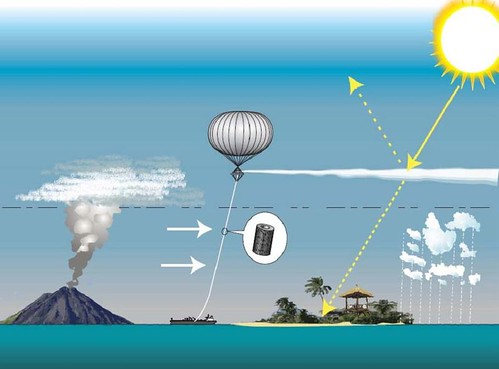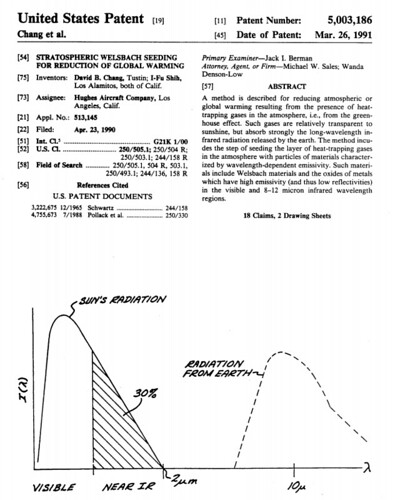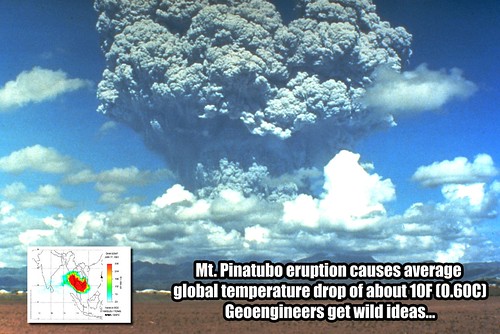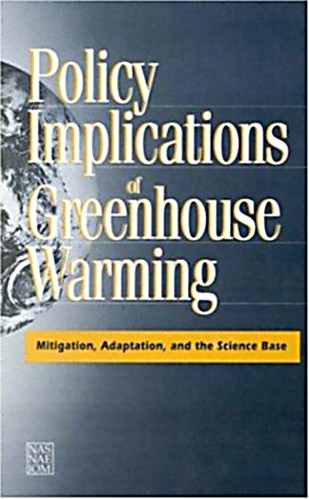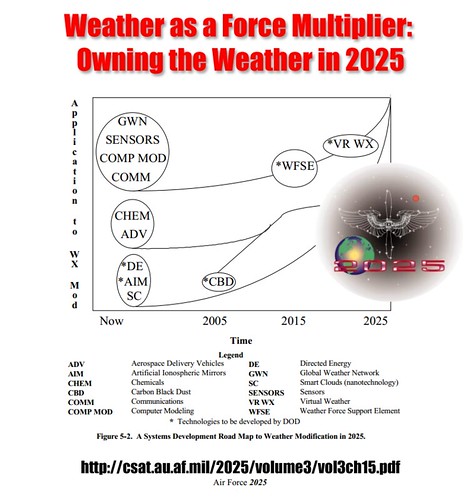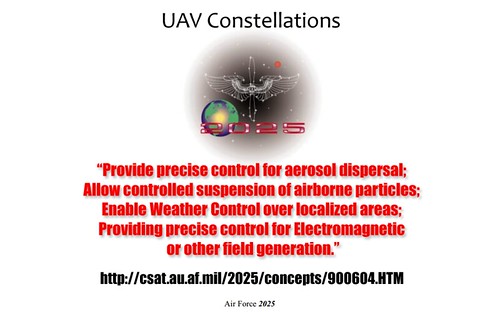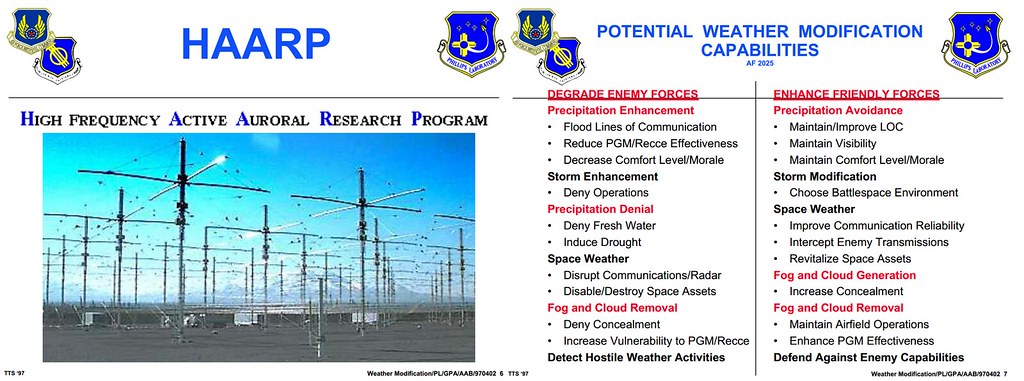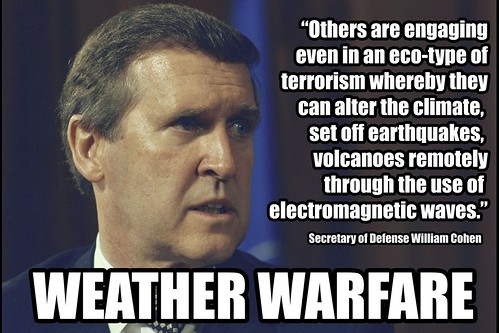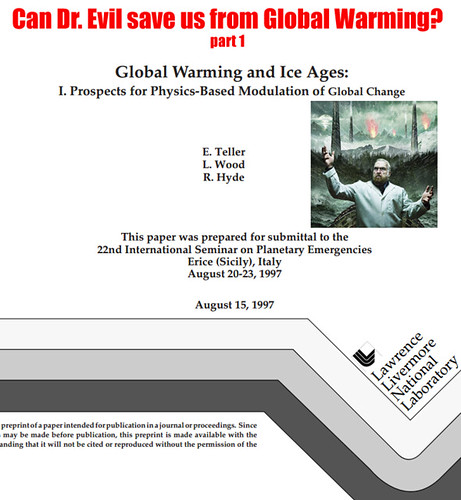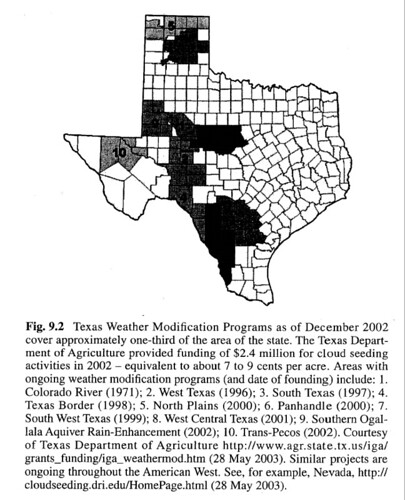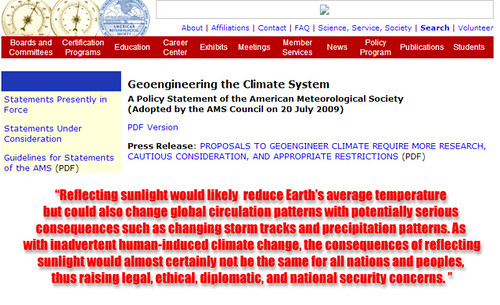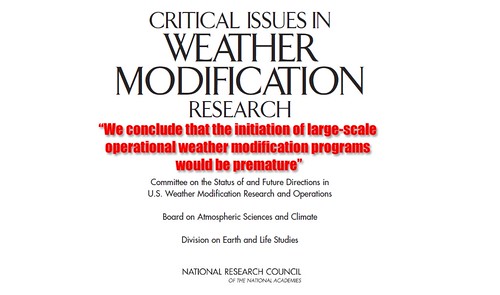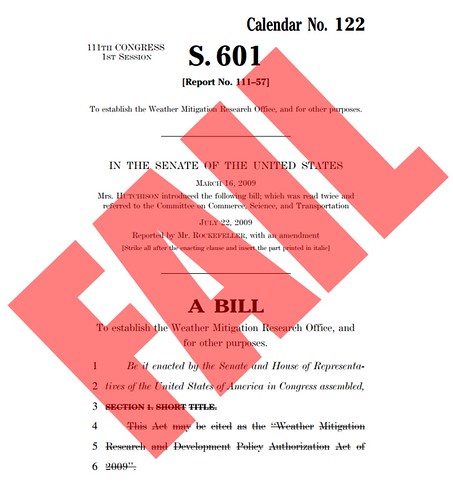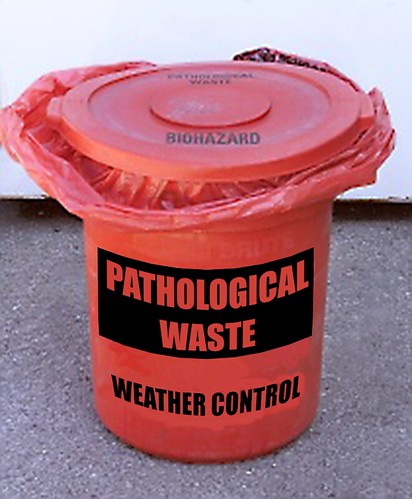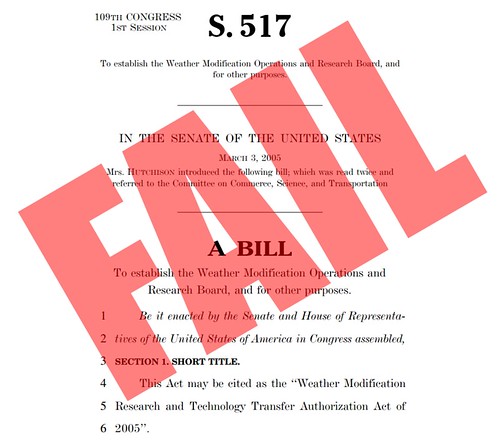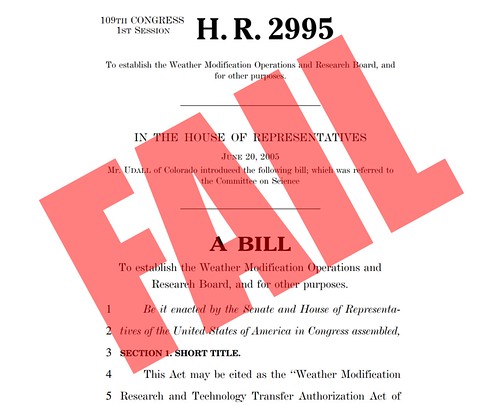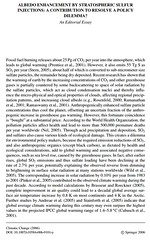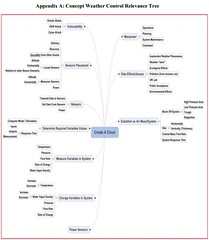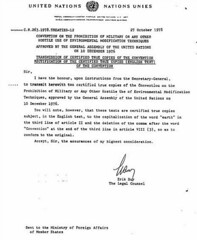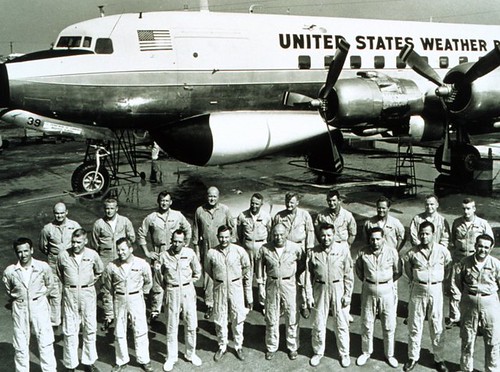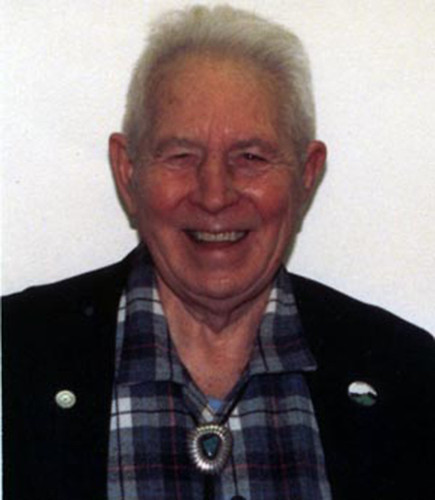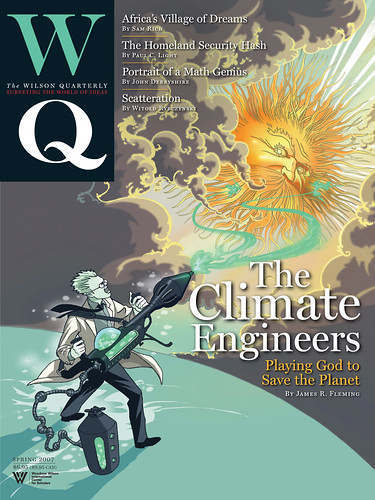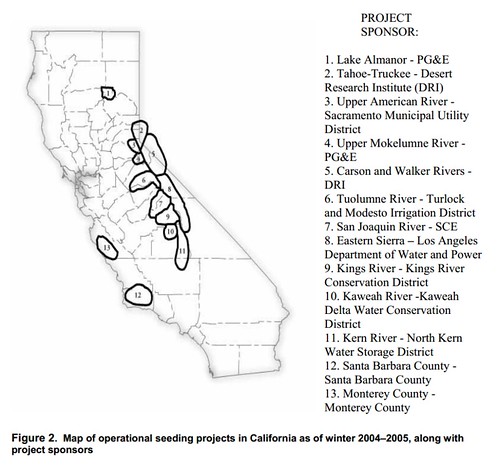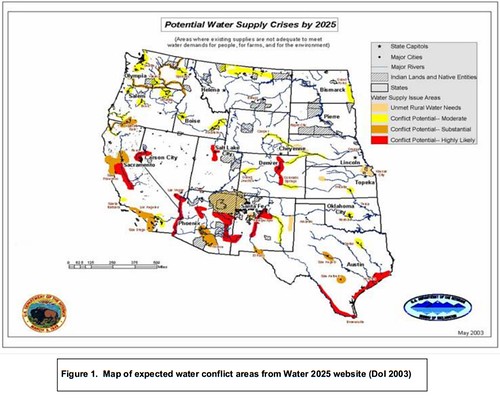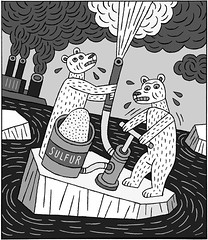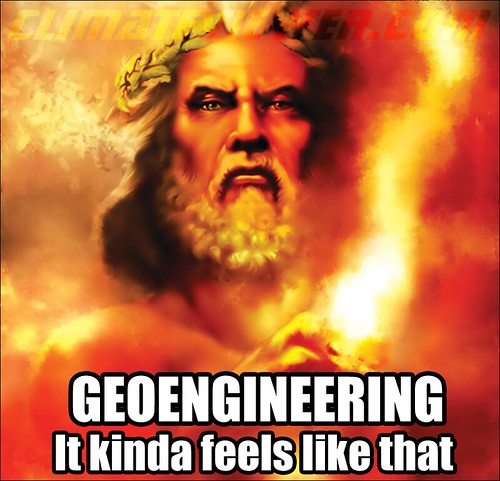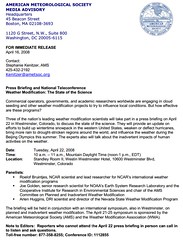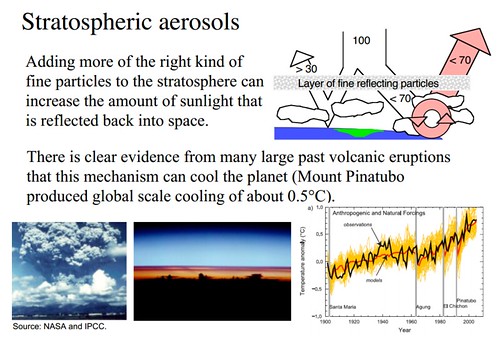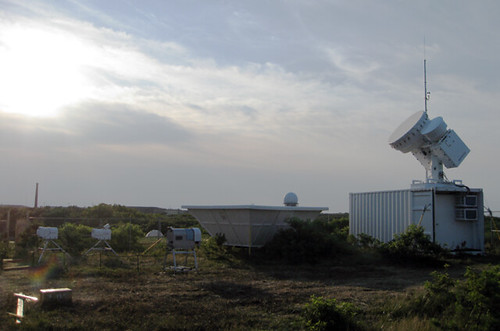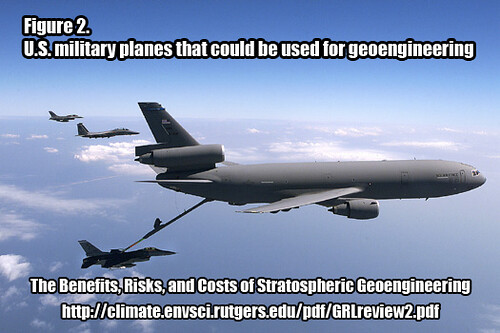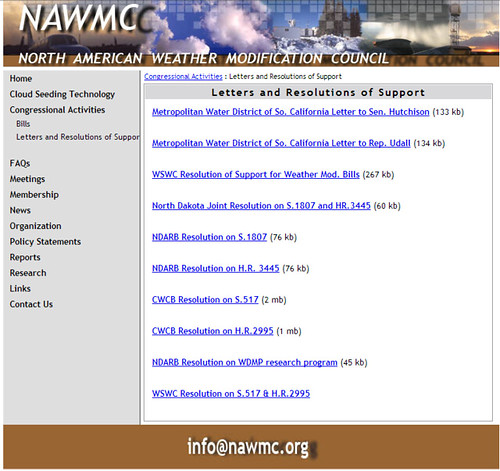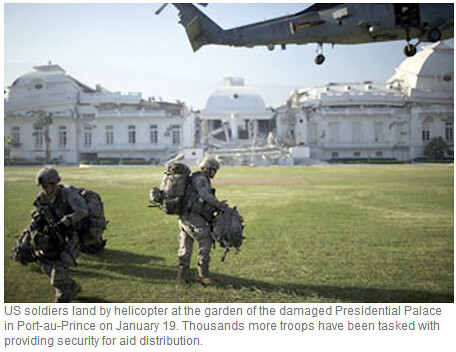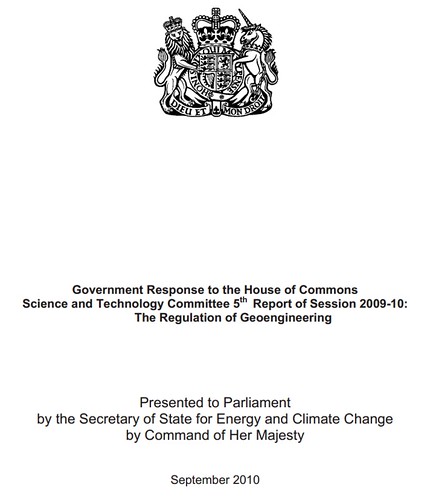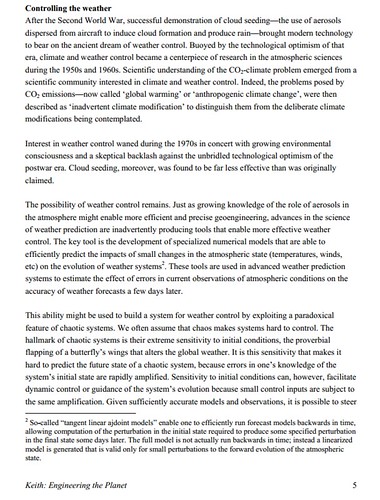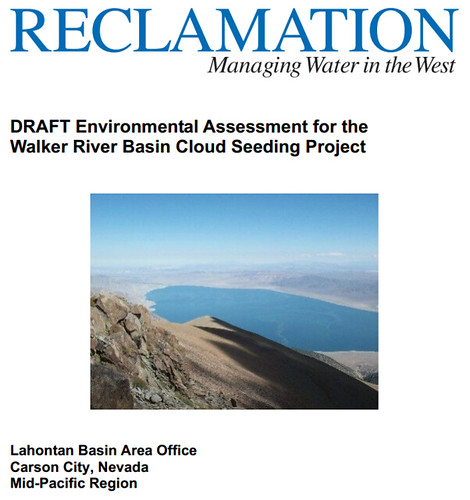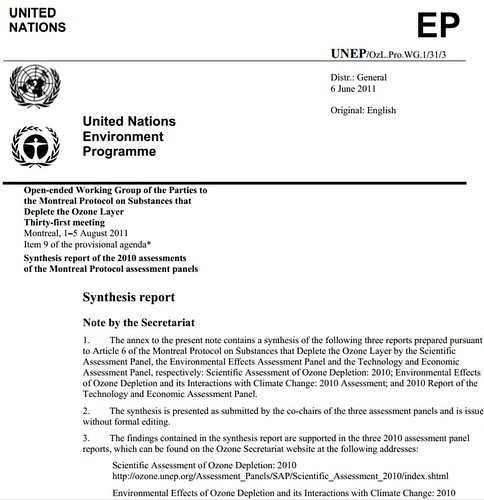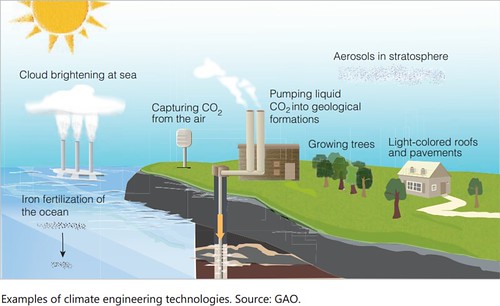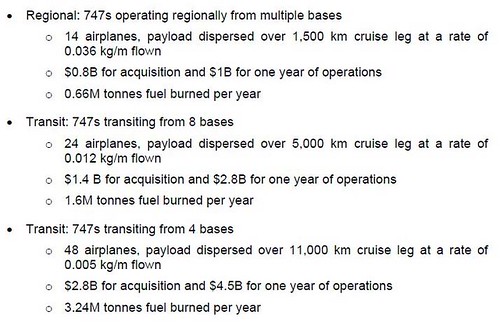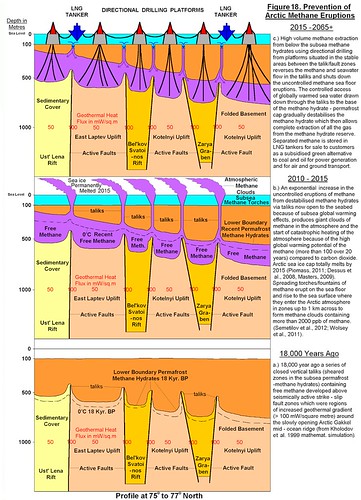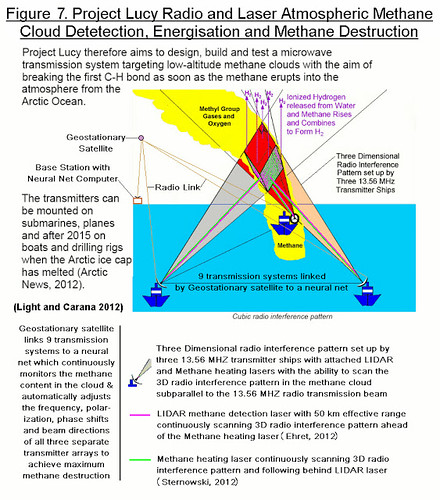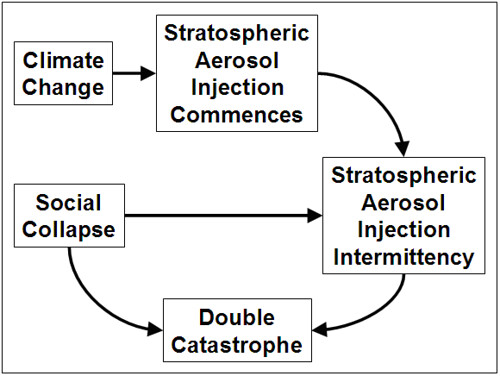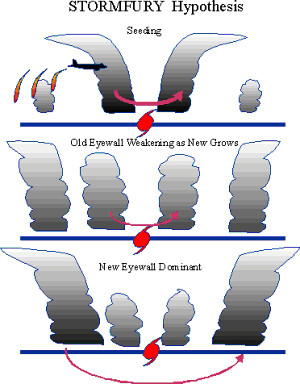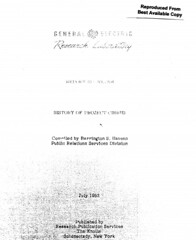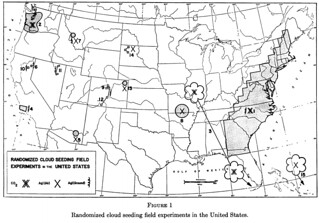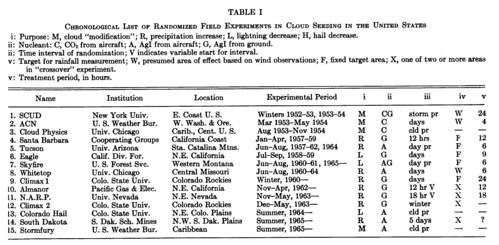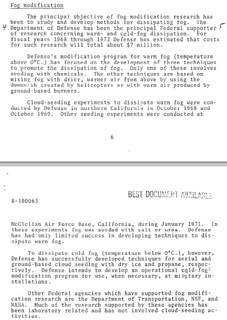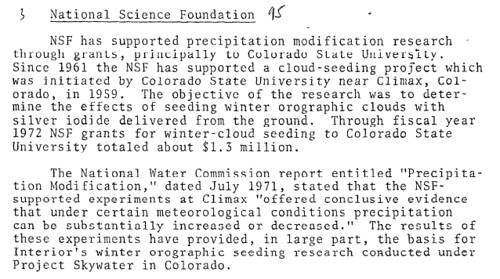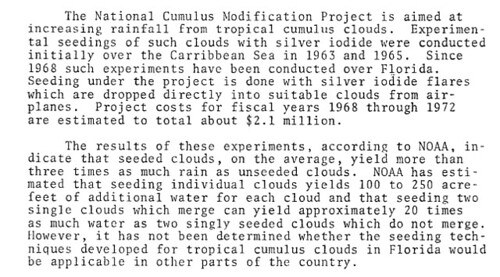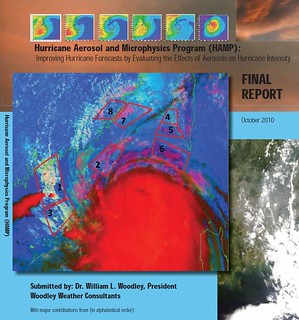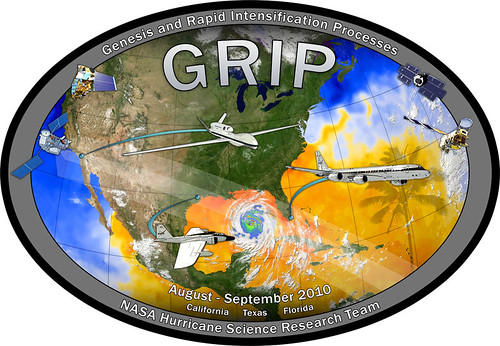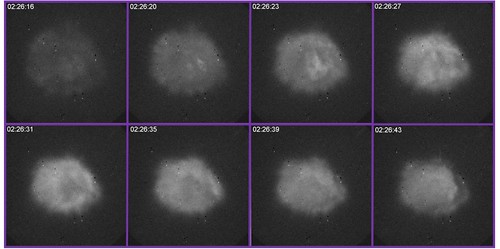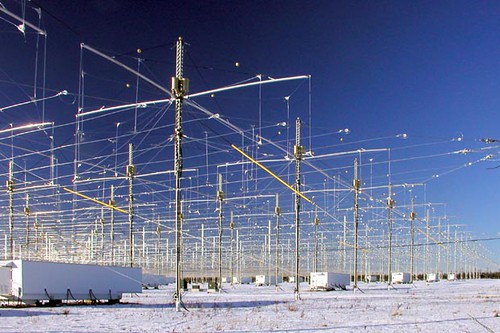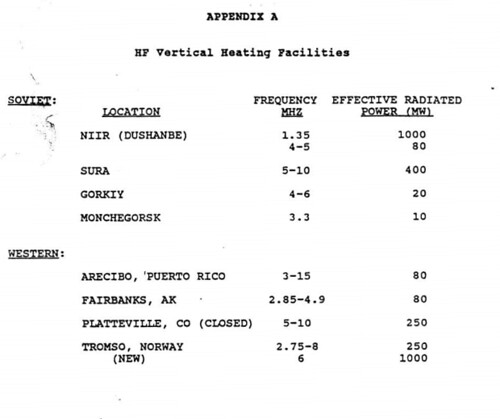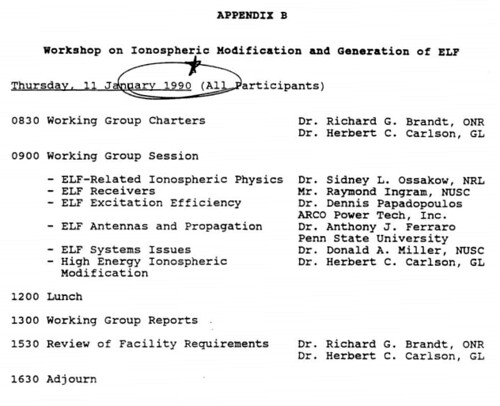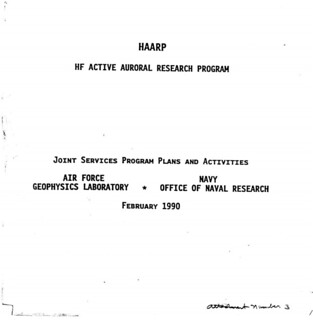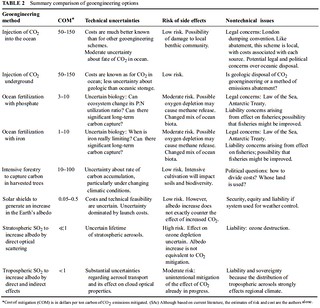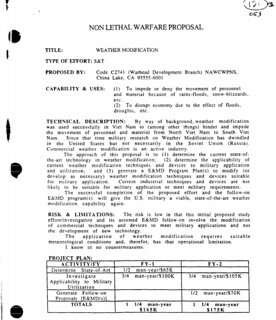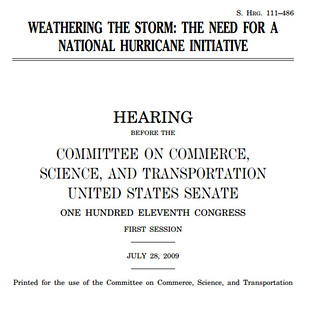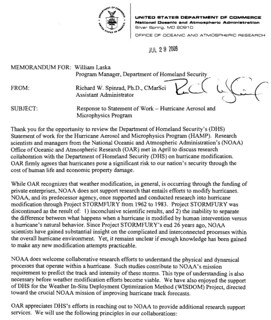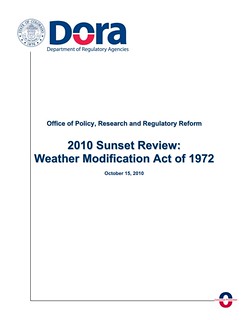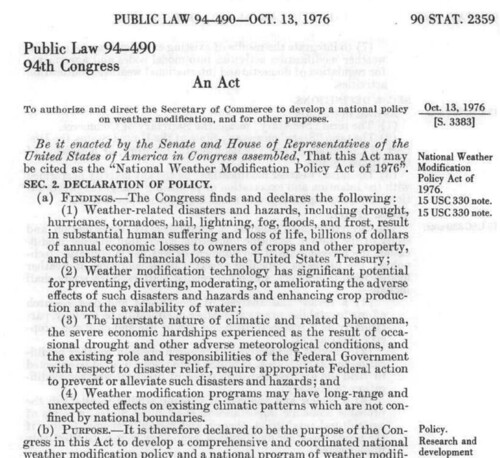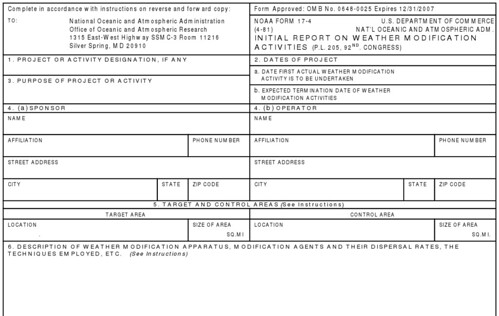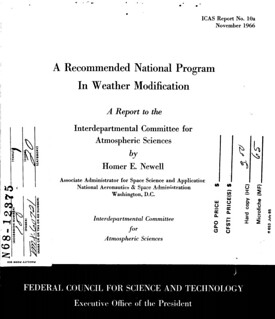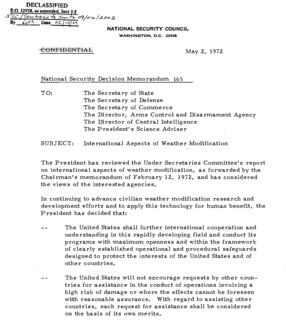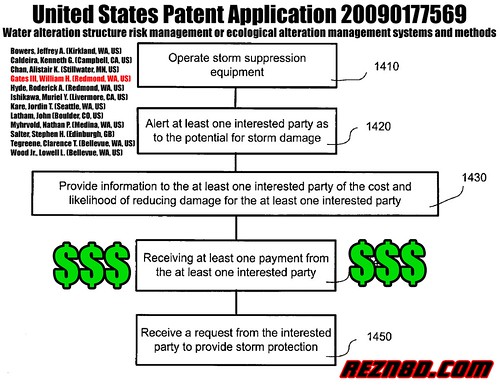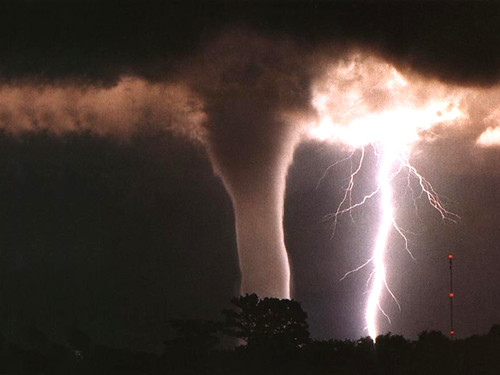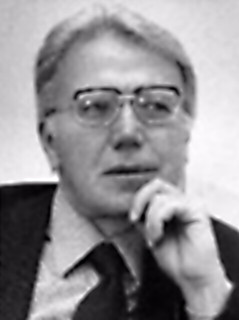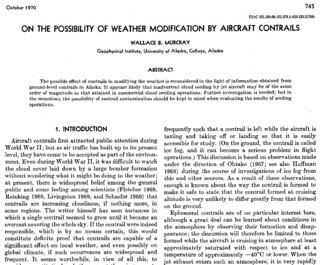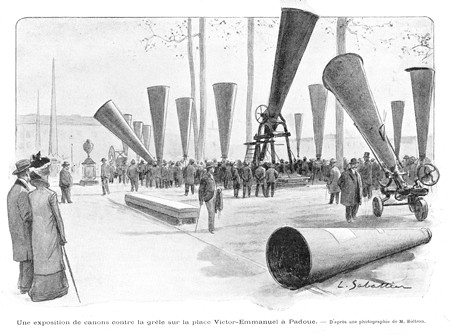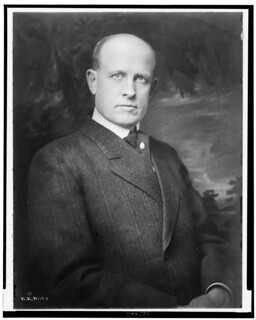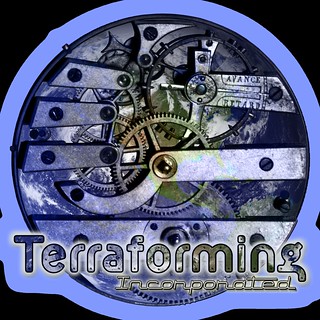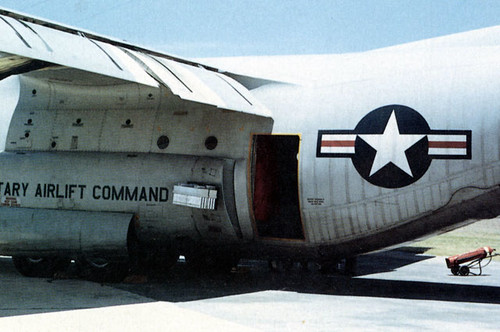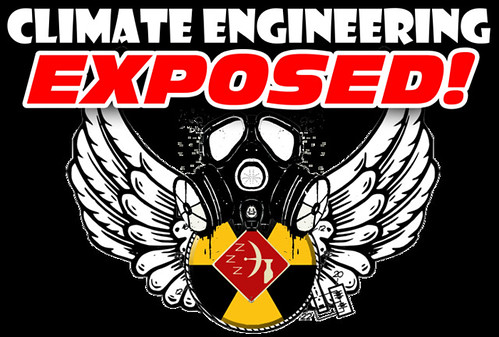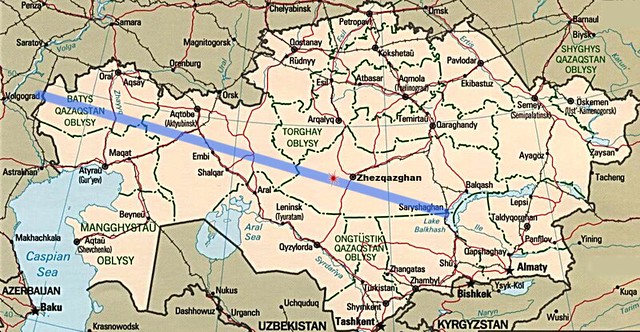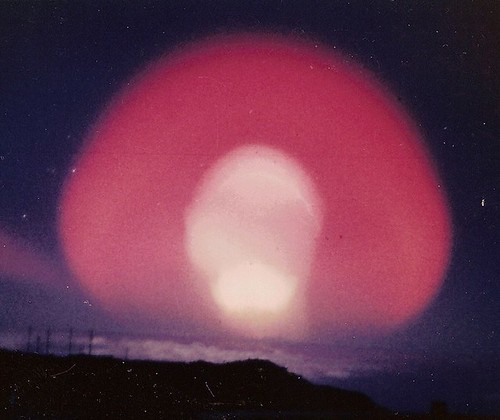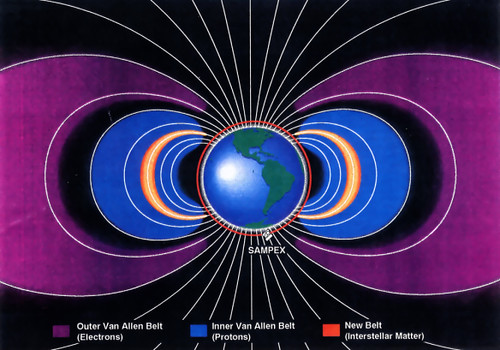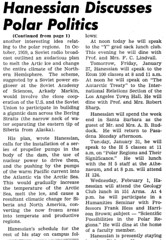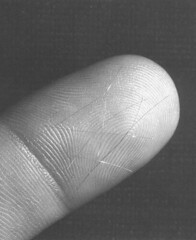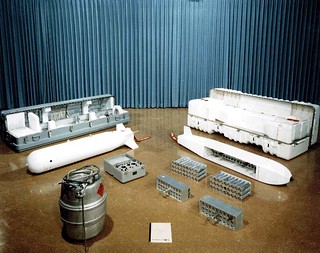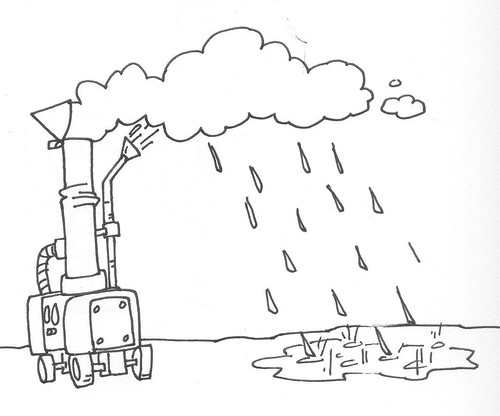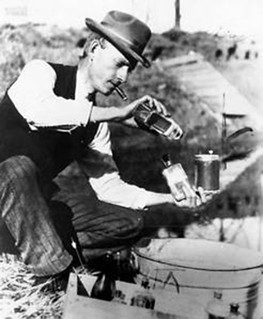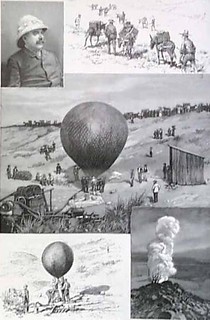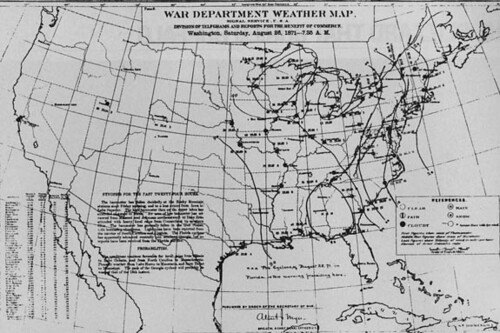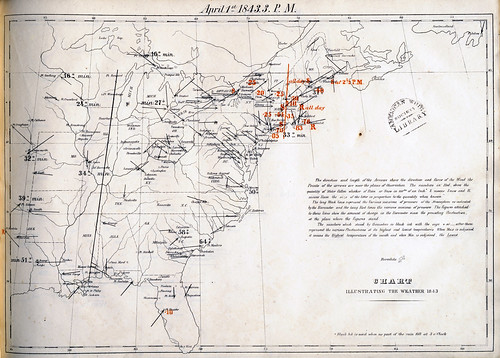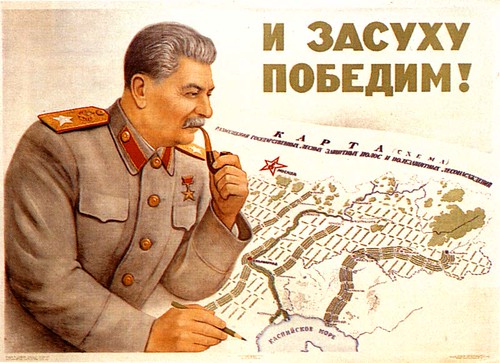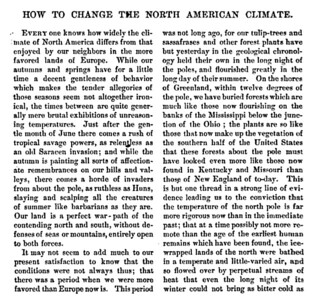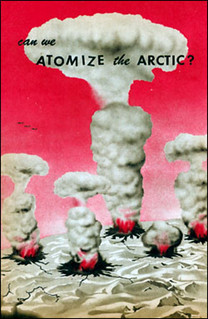Defense.gov Transcript: DoD News Briefing: Secretary of Defense William S. Cohen
THe entire transcript can be found at the link above...but here is the 'ecoterrorism' excerpt below.
"...There are some reports, for example, that some countries have been trying to construct something like an Ebola Virus, and that would be a very dangerous phenomenon, to say the least. Alvin Toeffler has written about this in terms of some scientists in their laboratories trying to devise certain types of pathogens that would be ethnic specific so that they could just eliminate certain ethnic groups and races; and others are designing some sort of engineering, some sort of insects that can destroy specific crops. Others are engaging even in an eco- type of terrorism whereby they can alter the climate, set off earthquakes, volcanoes remotely through the use of electromagnetic waves. "
=================================================
There is also a UN Treaty banning hostile use of environmental modification techniques from 1977! It was around then....imagine what they can do now...
http://en.wikipedia.org/wiki/Environmental_Modification_Convention
Environmental Modification Convention
The Environmental Modification Convention (ENMOD), formally the Convention on the Prohibition of Military or Any Other Hostile Use of Environmental Modification Techniques is an international treaty prohibiting the military or other hostile use of environmental modification techniques having widespread, long-lasting or severe effects. It opened for signature on 18 May 1977 in Geneva and entered into force on 5 October 1978.
The Convention bans weather warfare, which is the use of weather modification techniques for the purposes of inducing damage or destruction. The Convention on Biological Diversity of 2010 would also ban some forms of weather modification or geoengineering.[2]
I seek the truth about the oilspill,BP,advanced technologies used by the military industrial complex, HAARP, weather modification, chemtrails, man-made disasters includiing geoengineered ones like earthquakes and hurricanes, and the true capabilities of all the sciences which were coopted long ago.
FAIR USE NOTICE
FAIR USE NOTICE: The information and materials used on this blog, i.e. articles, videos,etc., may contain copyrighted (© ) material the use of which has not always been specifically authorized by the copyright owner. Such material is made available to advance understanding of ecological, political, human rights, economic, democracy, scientific, moral, ethical, and social justice issues, spiritual, religious, etc. It is believed that this constitutes a 'fair use' of any such copyrighted material as provided for in section 107 of the US Copyright Law. In accordance with Title 17 U.S.C. Section 107, this material is distributed without profit to those who have expressed a prior general interest in receiving similar information for research and educational purposes. For more information go to: /http://www.law.cornell.edu/uscode
Showing posts with label Controlling the weather. Show all posts
Showing posts with label Controlling the weather. Show all posts
Friday, February 27, 2015
Wednesday, February 4, 2015
Weather Control , Disney's science-factual presentation 1959
Weather Control , Disney's science-factual
presentation 1959
Uploaded on Dec 3, 2011
Clips extracted from " Eyes in Outer space " , a 1959 science factual presentation of Disney Studios , advised by the United States Department of Defense, Army, Navy, Air Force, where is developed a science fiction view of the possibilities and actual and future intentions of weather control, by military institutions .......... what is happening now, in a climatological crisis, mainly because this attempts ? ?
satellite operations
electronic, psychotronic, or information weapons;
chemtrails;
high altitude ultra low frequency weapons systems;
plasma, electromagnetic, sonic, or ultrasonic weapons;
laser weapons systems;
strategic, theater, tactical, or extraterrestrial weapons; and
chemical, biological, environmental, climate, or tectonic weapons.
satellite operations
electronic, psychotronic, or information weapons;
chemtrails;
high altitude ultra low frequency weapons systems;
plasma, electromagnetic, sonic, or ultrasonic weapons;
laser weapons systems;
strategic, theater, tactical, or extraterrestrial weapons; and
chemical, biological, environmental, climate, or tectonic weapons.
Tuesday, February 3, 2015
1978 Full text of "Weather modification: programs, problems, policy, and potential"
Full text of "Weather modification: programs, problems, policy, and potential"
From 1978... the full text can be found at the link above...I am copuing through the contents , summary and conclusions up to where the text actually starts....
===========================================================
95 2d affi" } COMMITTEE PRINT
WEATHER MODIFICATION:
PROGRAMS, PROBLEMS, POLICY, AND
POTENTIAL
Prepared at the Keqtiest of
Hon. Howard W. Cannon, Chairman
COMMITTEE ON COMMERCE,
SCIENCE, AND TRANSPORTATION
UNITED STATES SENATE
Printed for the use of the
Committee on Commerce, Science, and Transportation
r
95 S Congress I COMMITTEE PRINT
2d Session J
WEATHER MODIFICATION:
PROGRAMS, PROBLEMS, POLICY, AND
POTENTIAL
Prepared at the Request of
Hox. Howard W. Cannon, Chairman
COMMITTEE ON COMMERCE,
SCIENCE, AND TRANSPORTATION
UNITED STATES SENATE
MAY 1978
Printed for the use of the
Committee on Commerce, Science, and Transportation
U.S. government printing office
34-857 WASHINGTON : 1978
COMMITTEE ON COMMERCE, SCIENCE, AND TRANSPORTATION
HOWARD W. CANNON, Nevada, Chairman
WARREN G. MAGNUSON, Washington
RUSSELL B. LONG, Louisiana
ERNEST F. HOLLINGS, South Carolina
DANIEL K. INOUYE, Hawaii
ADLAI E. STEVENSON, Illinois
WENDELL H. FORD, Kentucky
JOHN A. DURKIN, New Hampshire
EDWARD ZORINSKY, Nebraska
DONALD W. RIEGLE, Jr., Michigan
Aubrey L. Sarvis, Staff Director and Chief Counsel
Edwin K. Hall, General Counsel
Malcolm M. B. Sterrett, Minority Staff Director
JAMES B. PEARSON, Kansas
ROBERT P. GRIFFIN, Michigan
TED STEVENS, Alaska
BARRY GOLDWATER, Arizona
BOB PACKWOOD, Oregon
HARRISON H. SCHMITT, New Mexico
JOHN C. DANFORTH, Missouri
LETTER OF TRANSMITTAL
U.S. Senate,
Committee on Commerce, Science, and Transportation,
November 15, 1978.
To the members of the Committee on Commerce. Science, and
Transportation, U.S. Senate:
I am pleased to transmit herewith for your information and use the
following report on "Weather Modification: Programs, Problems,
Policy, and Potential."
The report was prepared at my request by the Congressional Re-
search Service under the direction of Dr. Robert Morrison, Specialist
in Earth Sciences, Science Policy Research Division. We thank Dr.
Morrison and the others involved in the study for their extremely
thorough and scholarly report. Substantial material on almost all
areas of weather modification are included and the report will provide
the committee with an excellent reference source for future delibera-
tions on the subject.
The completion of the report is particularly timely due to the up-
coming recommendations expected from the Weather Modification
Advisory Board and the Department of Commerce (as directed by
Public Law 94-490) on the future Federal role in weather
modification.
James B. Pearson,
Ranking minority member.
(in)
LETTER REQUESTING STUDY
U.S. Senate,
Committee on Commerce, Science, and Transportation,
Washington, D.C., July 30, 1976.
Dr. Norman A. Beckman,
Acting Director, Congressional Research Service,
Library of Congress, W ashington, D.C.
Dear Dr. Beckman: Weather modification, although a relatively
young science, has over the years stimulated great interest within the
scientific, commercial, governmental, and agricultural communities.
Such responses are readily understandable. Weather-related disasters
and hazards affect virtually all Americans and annually cause untold
human suffering and loss of life and result in billions of dollars of eco-
nomic loss to crops and other property. While weather modification
projects have been operational for nearly 25 years and have been
shown to have significant potential for preventing, diverting, moderat-
ing, or ameliorating the adverse effects of such weather related disas-
ters and hazards, I am greatly concerned regarding the lack of a
coordinated Federal weather modification policy and a coordinated
and comprehensive program for weather modification research and
development. This fact is all the more disturbing in view of the mani-
fest needs, and benefits, social and economic, that can be associated with
weather modification activities. These deficiencies in our Federal orga-
nizational structure have resulted in a less than optimal return on our
investments in weather modification activities and a failure, with few
exceptions, to recognize that much additional research and develop-
ment needs to be carried out before weather modification becomes a
truly operational tool.
Reports and studies conducted by such diverse organizations as the
National Academy of Sciences, the National Advisory Committee on
Oceans and Atmosphere, the General Accounting Office, and the
Domestic Council have highlighted the lack of a comprehensive Federal
weather modification policy and research and development program.
Hearings that I chaired in February of this year reinforced my con-
cerns regarding the wisdom of our continued failure to implement a
national policy on this very important issue.
I am therefore requesting the Congressional Research Service to
prepare a comprehensive report on weather modification. This report
should include a review of the history and existing status of weather
modification knowledge and technology; the legislative history of
existing and proposed domestic legislation concerning weather mod-
ification; socio-economic and legal problems presented by weather
modification activities; a review and analysis of the existing local,
State, Federal, and international weather modification organizational
(V)
VI
structure: international implications of weather modification activi-
ties: and a review and discussion of alternative U.S. and international
weather modification policies and research and development programs.
If you have any questions with respect to this request, please contact
Mr. Gerry J. Kovach, Minority Staff Counsel of the Senate Commerce
Committee. He has discussed this study with Mr. Robert E. Morrison
and Mr. John Justus of the Science Policy Division, Congressional
Research Service.
Very truly yours,
James B. Pearsox,
U.S. Senator.
LETTER OF SUBMITTAL
The Library of Congress,
congressional research service,
Washington, D.C., June 19, 1978.
Hon. James B. Pearson,
Committee on Commerce, Science, and Transportation,
U.S. Senate, Washington, D.C.
Dear Senator Pearson: The enclosed report, entitled "Weather
Modification: Programs, Problems, Policy, and Potential," has been
prepared by the Congressional Research Service in response to your
request.
The study reviews the history, technology, activities, and a number
of special aspects of the field of weather modification. Activities
discussed are those of the Federal, State, and local governments, of
private organizations, and of foreign nations. Consideration is given
to international, legal, economic, and ecological aspects. There are
also an introductory chapter which includes a summary of issues, a
chapter discussing inadvertent weather and climate modification, and
a chapter summarizing recommendations from major Federal policy
studies.
The study has been coordinated by Dr. Robert E. Morrison, Special-
ist in Earth Sciences, Science Policy Research Division, who also
prepared chapters 1, 2, 3, 5, 7, 8, and 9 as well as the Summary and
Conclusions. Mr. John R. Justus, Analyst in Earth Sciences, and
Dr. James E. Mielke, Analyst in Marine and Earth Sciences, both
of the Science Policy Research Division, contributed chapters 4 and
6, respectively. Chapter 10 was prepared by Mrs. Lois B. McHugh,
Foreign Affairs Analyst, Foreign Affairs and National Defense Di-
vision. Chapter 11 was written jointly by Mrs. Nancy Lee Jones,
Legislative Attorney, and Mr. Daniel Hill Zaf ren, Specialist in Ameri-
can Public Law, both of the American Law Division. Dr. Warren
Viessman, Jr., Senior Specialist in Engineering and Public Works,
contributed chapter 12; and Mr. William C. JolW, Analyst in En-
vironmental Policy, Environment and Natural Resources Division,
was responsible for chapter 13. In addition, appendixes C, F, Q, and R
were assembled by Mrs. McHugh ; appendixes D and S were prepared
by Mrs. Jones; and information in the remaining appendixes was
collected by Dr. Morrison.
I trust that this report will serve the needs of the Committee on
Commerce, Science, and Transportation as well as those of other
committees and individual Members of Congress who are concerned
with weather modification. On behalf of the Congressional Research
Service, I wish to express my appreciation for the opportunity to
undertake this timely and worthwhile assignment.
Sincerely,
Gilbert Gtjde,
Director.
(VII)
Digitized by the Internet Archive
in 2013
http://archive.org/details/weatificatOOunit
CONTENTS
Page
Letter of transmittal in
Letter requesting study v
Letter of submittal vn
Summary and conclusions xix
Chapter 1
Introduction and summary of issues 1
Perspective 1
Situation 1
Advantages 3
Timeliness 5
Definitions and scope of report 7
Summary of issues in planned weather modification 9
Technological problems and issues 9
Governmental issues 12
The role of the Federal Government 12
Roles of State and local governments 14
Legal issues 15
Private rights in the clouds 15
Liability for weather modification 16
Interstate legal issues 17
International legal issues 17
Economic issues 18
Issues complicating economic analyses of weather modifica-
tion 18
Weather modification and conflicting interests 19
Social issues 19
Social factors 20
Need for public education on weather modification 21
Decisionmaking 22
International issues 23
Ecological issues 24
Chapter 2
History of weather modification 25
Introduction 25
History of weather modification prior to 1946 26
Prescientific period 26
Early scientific period 27
Development of scientific fundamentals 32
Early cloud-seeding experiments 34
Weather modification since 1946 35
Chronology 35
Langmuir, Schaefer, and Vonnegut 37
Research projects since 1947 39
Project Cirrus 39
The Weather Bureau cloud phvsics project 41
The U.S. experiments of 1953-54 42
Arizona Mountain cumulus experiments 44
Project Whitetop 44
Climax experiments 45
Lightning suppression experiments 46
Fog dispersal research 46
Hurricane modification. 46
Hail suppression 46
Foreign weather modification research 47
Commercial operations 48
History of Federal activities, committees, policy studies, and
reports 53
(IX)
X
Chapter 3
Page
Technology of planned weather modification 55
Introduction 55
Assessment of the status of weather modification technology 56
Classification of weather modification technologies 61
Principles and status of weather modification technologies 62
Precipitation augmentation 64
Cumulus clouds 66
Cumulus modification experiments 67
Effectiveness of precipitation enhancement research and
operations 69
Results achieved through cumulus modification 70
Recent advances in cumulus cloud modification 71
Orographic clouds and precipitation 71
Orographic precipitation modification 75
Orographic seeding experiments and seedability criteria 77
Operational orographic seeding projects 81
Results achieved through orographic precipitation modifi-
cation 82
Hail suppression 84
The hail problem 84
Modification of hail 86
Hail seeding technologies 87
Evaluation of hail suppression technology 88
Surveys of hail suppression effectiveness 89
Conclusions from the TASH study 91
Dissipation of fog and stratus clouds 92
Cold fog modification 93
Warm fog modification 93
Lightning suppression 96
Lightning modification 98
Evaluation of lightning suppression technology 99
Modification of severe storms 101
Hurricanes 101
Generation and characteristics of hurricanes 104
Modification of hurricanes 108
Tornadoes 112
Modification of tornadoes 113
Technical problem areas in planned weather modification 115
Seeding technology 115
Evaluation of weather modification projects 118
Extended area effects of weather modification 124
Approaches to weather modification other than seeding 129
Research needs for the development of planned weather modification- 131
General considerations 131
Recommendations from the 1973 National Academv of Sciences
study i 134
Recommendations of the Advanced Planning Group of NOAA__. 136
Summary of Federal research needs expressed by State officials. 138
Research recommendations of the AMS Committee on Weather
Modification 139
Research recommendations related to extended area and time
effects 143
Chapter 4
Inadvertent weather and climate modification 145
Introduction 145
Terminology 145
Climate 145
Climatic fluctuation and climatic change 146
Weather 146
Weather modification 146
Climate modification 146
Planned climate modification 147
Inadvertent climate modification 148
XI
Page
Background 149
Historical perspective 149
Understanding the causes of climatic change and variability 151
The concept of climatic change and variability 152
When and how do climatic changes occur 154
The facts about inadvertent weather and climate modification 156
Airborne particulate matter and atmospheric turbidity 156
Do more particles mean a warming or cooling? 157
Sources of atmospheric particulates: Natural vs. manmade.. 158
Atmospheric processes affected by particulates 159
The La Porte weather anomaly: Urban climate modification. 162
Carbon dioxide and water vapor 164
Increases in atmospheric carbon dioxide concentration:
What the record indicates 164
Predicting future atmospheric carbon dioxide levels 166
Sources and sinks for carbon dioxide 168
Atmospheric effects of increased carbon dioxide levels 169
Implications of increasing atmospheric carbon dioxide con-
centrations 169
Implications of a climatic warming 170
Carbon dioxide and future climate: The real climate vs.
"model climate" 171
Ozone depletion 172
Concerns regarding ozone destruction 172
Action by the Government on the regulation of fluorocar-
bons 175
Climatic effects of ozone depletion 176
Waste heat 177
The urban "Heat Island" 177
Albedo 179
Large-scale irrigation 180
Recapitulation 181
Issues in inadvertent weather and climate modification 184
Climatic barriers to long-term energy growth 184
Thoughts and reflections — Can we contemplate a fossil-fuel-free
world? 185
Research needs and deficiencies 186
Chapter 5
Federal activities in weather modification 193
Overview of Federal activities..-- '— — 193
Legislative and congressional activities 194
Federal legislation on weather modification 194
Summary 194
The Advisory Committee on Weather Control 195
Direction to the National Science Foundation 196
Reporting of weather modification activities to the Federal
Government 197
The National Weather Modification Policy Act of 1976 198
Congressional direction to the Bureau of Reclamation 201
Proposed Federal legislation on weather modification 203
Summary 203
Legislation proposed in the 94th Congress and the 95th
Congress, 1st sessions 205
Other congressional activities 207
Resolutions on weather modification 207
Hearings 208
Studies and reports by congressional support agencies 209
Activities of the executive branch 209
Introduction 209
Institutional structure of the Federal weather modification
program 210
Current status of Federal organization for weather modifica-
tion 210
xn
3?a?e
Federal structure; 1946-57 214
Federal structure; 1958-68 215
Federal structure; 1968-77 216
Future Federal organization for weather modification 216
Coordination and advisory mechanisms for Federal weather
modification programs 221
Introduction 221
The Interdepartmental Committee for Atmospheric Sciences
(ICAS) 222
The National Academv of Sciences/Committee on At-
mospheric Sciences (N AS/CAS) 226
The National Advisory Committee on Oceans and Atmos-
phere (NACOA) 227
Other coordination and advisory mechanisms 228
Weather Modification Advisory Board 231
Weather modification activities reporting program 232
Background and regulations 232
Reporting of Federal activities 233
Summary reports on U.S. weather modification activities 233
Federal studies and reports on weather modification 234
Introduction 234
Studies of the early 1950's 235
Advisory Committee on Weather Control 236
National Academy of Sciences studies 237
Studies bv the Interdepartmental Committee for Atmos-
pheric Sciences (ICAS) 238
Domestic Council study 239
Policy and planning reports produced by Federal agencies 239
Federal programs in weather modification 241
Introduction and funding summaries 241
Department of the Interior 246
Introduction 246
Project Skywater; general discussion 247
The Colorado River Basin Pilot Project (CRBPP) 254
The High Plains Cooperative Program (HIPLFX) 258
The Sierra Cooperative Pilot Project (SCPP) 263
Drought mitigation assistance 266
National Science Foundation 267
Introduction and general 267
Weather hazard mitigation 274
Weather modification technology development 282
Inadvertent weather modification 283
Societal utilization activities 287
Agricultural weather modification 288
Department of Commerce 290
Introduction and general discussion 290
The Florida Area Cumulus Experiment (FACE) 292
Project Stormfurv 296
Research Facilities Center (RFC) 300
Global Monitoring for Climatic Change (GMCC) 301
Lightning suppression 302
Modification of extratropical severe storms 302
Department of Defense 303
Introduction 303
Air Force fog dispersal operations 303
Army research and development 304
Navy research and development 304
Air Force research and development 305
Overseas operations 307
Department of Transportation 308
Department of Agriculture 309
Department of Energy 310
XIII
Chapter 6
Review of recommendations for a national program in weather modifica- Page
tion 313
Introduction ^Jy
Summaries of major weather modification reports 314
Final report of the Advisory Committee on Weather Control — 314
Weather and climate modification: Report of the Special Com-
mission on Weather Modification 315
Weather and climate modification: Problems and prospects 317
A recommended national program in weather modification 318
A national program for accelerating progress in weather modifica-
tion 320
Weather and climate modification: Problems and progress 321
Annual reports to the President and Congress by NACOA 323
Need for a national weather modification research program 324
The Federal role in weather modification 325
Trends and analysis 326
Chapter 7
State and local activities in weather modification 331
Overview of State weather modification activities 331
Introduction 331
North American Interstate Weather Modification Council 333
Survey and summary of State interests and activities in weather
modification 340
State contacts for information on weather modification activities. 343
Non-Federal U.S. weather modification activities 343
Analysis of calendar year 1975 projects 344
Preliminary analysis of projects for calendar years 1976-77_ 347
General discussion of local and regional weather modification policy
activities „ 348
Weather modification activities within particular States 351
California 352
State weather modification law and regulations 352
Weather modification projects 353
State-sponsored emergency projects 356
Illinois 358
Illinois weather modification law and its administration 358
Operational projects 359
Research activities 360
Kansas 361
Kansas Weather Modification Act 361
Research activities 362
Operational activities 364
Emergenc}- Drought Act of 1977 364
North Dakota 365
Weather modification law and administration of regulations- 365
Authority and organization for local projects 370
North Dakota operational projects in 1975 and 1976 371
South Dakota 376
Utah 381
Washington 382
Chapter 8
Private activities in weather modification 385
Introduction 385
Commercial weather modifiers 386
Scope and significance of contract activities 386
Summary of contract services 386
Evaluation and research by commercial firms 388
Participation in Federal research programs 389
Weather modification organizations 389
Professional organizations 389
Weather Modification Association 390
American Meteorological Society 395
XIV
Page
Opposition to weather modification 399
General discussion 399
Opposition to the seeding project above Hungry Horse Dam. 399
Tri-State Natural Weather Association 400
Citizens for the Preservation of Natural Resources 402
Chapter 9
Foreign'activities in weather modification 405
Introduction 405
World Meteorological Organization register of weather modification
projects 408
Description of weather modification activities in some foreign nations. 412
The Union of Soviet Socialist Republics 412
Overview of projects in the U.S.S.R 412
Summary of weather modification and related atmospheric
research in the U.S.S.R 413
Israel 415
Australia 416
Canada 418
Mexico 419
People's Republic of China 420
Kenya 421
Republic of South Africa 422
Rhodesia 423
India 423
The Swiss hail experiment 424
Chapter 10
International aspects of weather modification 427
Introduction 427
Convention on the prohibition of military or any other hostile use of
environmental modification techniques 429
Development of the treaty 429
Criticism of the convention 431
Activities since the United Nations approval of the convention.. 432
Activities of the World Meteorological Organization in weather
modification 433
Precipitation enhancement program (PEP) 434
Other WMO activities in weather modification 436
Registration and reporting of weather modification projects. 436
WMO conferences on weather modification 436
Typhoon and serious storm modification 437
Global atmospheric research programme 437
Legal aspects of weather modification 437
United Nations Conference on the Human Environment 438
Declaration of the United Nations Conference on the Human
Environment 438
Action Plan for the Human Environment 438
Earthwatch Program 439
Study of Man's Impact on Climate 439
Other international activities 440
United States/Canadian agreement 440
North American Interstate Weather Modification Council 440
Congressional activities 441
Weather modification as a weapon of war 441
Senate Resolution 71, prohibiting environmental modification
as a weapon of war 441
Congressional activities related to hostile use of weather
modification, 1974-76 442
Other Congressional actions relating to weather modification 443
Senate Concurrent Resolution 67 — U.S. participation in the
world weather program 443
National Weather Modification Policy Act of 1976 444
Senate Resolution 49 444
XV
Page
U.S. foreign policy 444
Various executive branch proposals 445
National Advisory Committee on Oceans and Atmosphere 447
Activities in 1977 448
Chapter 11
Legal aspects of weather modification 449
Domestic 449
Private rights in the clouds 449
Liability for weather modification 453
Defenses which may be raised against claims of liability 456
Interstate allocation of atmospheric water 457
Methods of controlling weather modification 459
Congressional authority under the Constitution to regulate or
license weather modification activities 461
Federalism 461
The commerce clause 461
The commerce clause generally 462
The commerce clause and the regulation of navigable
waters 463
Limitations on the commerce power 464
Fiscal powers 465
War powers 466
Property power 466
Treaty power 467
Conclusion 467
International 468
Certain hostile uses of weather modification are prohibited 471
Nations are responsible for environmental conduct which causes
injury or damage in or to other nations 471
Nations are liable for injuries sustained by aliens within their
territory caused by tortuous conduct in violation of inter-
national law 472
Nations or their citizens may be liable for injury and damage
they caused to citizens of another nation occurring in that
nation 472
Chapter 12
Economic aspects of weather modification 475
Introduction 475
Economic setting 476
Economic aspects of weather modification procedures 477
Fog dispersal 477
Precipitation augmentation 478
Orographic cloud seeding 478
Convective cloud seeding 478
Precipitation augmentation and energy considerations 479
Hail suppression 480
Lightning suppression and reduction in storm damage 480
Analytic methods for economic analysis 481
Case studies of the economics of weather modification 482
Hungry Horse Area, Montana 482
Connecticut River basin 483
State of Illinois 483
Nine-county Southeastern Crop Reporting District, South Dakota, 483
Colorado River 484
Conclusions 486
Chapter 13
Ecological effects of weather modification 487
Introduction 487
Modification of weather and climate 487
Ecology and ecological systems — 487
Knowledge of ecological implications of applied weather modifi-
cation technologies 488
XVI
Page
Important variables 490
Temporal considerations 491
Season of modification effort 491
Duration of effort: Short- v. long-term 491
Regularity of modification effort 491
Ecosystem type 492
Aquatic v. terrestrial systems 492
Cultivated v. natural systems 492
Arid v. humid systems 492
Cumulative and synergistic effects 492
Effects of silver iodide* 493
Deliberate weather modification 496
Precipitation enhancement 496
Increased rainfall 496
Snowpack augmentation 497
Severe storm abatement 498
Fog dispersal 499
Hail suppression 499
Alteration or arrest of lightning discharges 499
Inadvertent weather modification 499
Extra-area effects 499
Long-term, climatic, and global implications 500
Summary and conclusions 501
Appendixes
A. Statement on weather modification in Congressional Record of
June 17, 1975, by Congressman Gilbert Gude, containing White
House statement on Federal weather modification policy 503
B. Department of Defense statement on position on weather modification. 509
C. Text of United Nations Convention on the prohibition of military
or any other hostile use of environmental modification techniques 510
D. State statutes concerning weather modification 514
Arizona 515
California 516
Colorado 520
Connecticut 528
Florida 529
Hawaii 531
Idaho 531
Illinois 533
Iowa 541
Kansas 543
Louisiana 549
Minnesota 550
Montana 554
Nebraska 557
Nevada 565
New Hampshire 571
New Mexico 571
New York 573
North Dakota 573
Oklahoma 584
Oregon 59 1
Pennsylvania 599
South* Dakota 604
Texas 600
Utah 612
Washington 613
West Virginia 618
Wisconsin 622
Wyoming 622
E. List of State contacts for further information on weather modification
activities within the States 625
F. Agreement on exchange of information on weather modification
between the United States of America and Canada 627
XVII
G. Weather modification activities in the United States during calendar Pa?e
year 1975 630
H. Selected bibliography of publications in weather modification 641
I. Public laws dealing specifically with weather modification 640
J. Summary of language in congressional documents supporting public
works appropriations for the Bureau of Reclamation's atmospheric
water resources program 655
K. Membership and charter of the U.S. Department of Commerce
Weather Modification Advisory Board 660
L. Rules and regulations and required forms for submitting information
on weather modification activities to the National Oceanic and
Atmospheric Administration, U.S. Department of Commerce, in
accordance with requirements of Public Law 92-205 662
M. Selected State rules and regulations for the administration of State
weather modification statutes 676
Illinois 676
Kansas 6 S3
North Dakota 691
Utah 707
Washington 712
N. Documents of the Weather Modification Association 717
O. Policy statement of the American Meteorological Society on purposeful
and inadvertent modification of weather and climate 722
P. Reporting agencies of member countries and questionnaire circulated
to receive weather modification information from members of the
World Meteorological Organization 724
Q. Report of the World Meteorological Organization/ United Nations
Environment programme informal meeting on legal aspects of
weather modification 727
R. Text of Senate Resolution 71; considered, amended, and agreed to
July 11, 1973 734
S. Reported cases on weather modification 740
T. Glossary of selected terms in weather modification 741
34-857—79 2
SUMMARY AND CONCLUSIONS
Weather modification is generally considered to be the deliberate
effort to improve atmospheric conditions for beneficial human pur-
poses — to augment water supplies through enhanced precipitation or
to reduce economic losses, property damages, and deaths through
mitigation of adverse effects of hail, lightning, fog, and severe storms.
Not all weather modification activities, however, have been or can be
designed to benefit everyone, and some intentional operations have
been used, or are perceived to have been used, as a weapon of war
to impede the mobility or tactical readiness of an enemy. Further-
more, environmental change is also effected unintentionally and with-
out any purpose at all, as man inadvertently modifies the weather and
climate, whether for better or worse scientists are not certain, through
activities such as clearing large tracts of land, building urban areas,
and combustion of fossil fuels.
Historically, there have been attempts, often nonscientific or pseudo-
scientific at best, to change the weather for man's benefit. Until the
20th century, however, the scientific basis for such activities was
meager, with most of our current understanding of cloud physics and
precipitation processes beginning to unfold during the 1930's. The
modern period in weather modification is about three decades old, dat-
ing from events in 1946, when Schaefer and Langmuir of the General
Electric Co. demonstrated that a cloud of supercooled water droplets
could be transformed into ice crystals when seeded with dry ice. Soon
afterward it was discovered that fine particles of pure silver iodide,
with crystal structure similar to that of ice, were effective artificial
ice nuclei, and that seeding clouds with such particles could produce
ice crystals at temperatures just below freezing. Silver iodide remains
the most often used material in modern "cloud seeding."
By the 1950's, many experimental and operational weather modifi-
cation projects were underway; however, these early attempts to
augment precipitation or to alter severe storm effects were often in-
conclusive or ineffective, owing to improper experimental design, lack
of evaluation schemes, and the primitive state of the technology.
Through research programs over the past two decades, including
laboratory studies and field experiments, understanding of atmos-
pheric processes essential to improved weather modification tech-
nology has been advanced. Sophisticated evaluation schemes have been
developed, using elaborate statistical tools; there has also been im-
provement in measuring instruments and weather radar systems ; and
simulation of weather processes using numerical models and high
speed computers has provided further insights. Meanwhile, commer-
cial weather modifiers, whose number decreased dramatically along
with the total area of the United States covered by their operations
after the initial surge of the 1950 era, have grown in respectability and
competence, and their operations have incorporated improvements as
they benefited from their accumulated experience and from the re-
(XIX)
XX
suits of research projects. Since such operations are designed for prac-
tical results, such as increased precipitation or reduced hail, however,
the sophisticated evaluation procedures now used in most research
projects are most often not used, so that the effectiveness of the opera-
tions is frequently difficult to assess.
Weather modification is at best an emerging technology. Progress in
development of the technology over the past 30 years has been slow,
although there has been an increased awareness of the complex nature
of atmospheric processes and a steady improvement in basic under-
standing of those processes which underlie attempts at deliberate modi-
fication of weather phenomena. Though most cloud-seeding practices
are based on a common theory and form the basis for a number of seed-
ing objectives, there are really a series of weather modification
technologies, each tailored to altering a particular atmospheric pheno-
menon and each having reached a different state of development and
operational usefulness. For example, cold fog clearing is now consid-
ered to be operational, while, at the other extreme, the abatement of
severe storms such as hurricanes remains in the initial research phase.
Development progress for each of these technologies appears to be
much less a function of research effort expended than a dependence on
the fundamental atmospheric processes and the ease by which they can
be altered. There continues to be obvious need for further research and
development to refine those few techniques for which there has been
some success and to advance technology where progress has been slow
or at a virtual standstill.
The following summary provides a reasonably accurate assessment
of the current status of weather modification technology :
1. The only routine operational projects are for clearing cold fog.
Research on warm fog has yielded some useful knowledge and good
models, but the resulting technologies are so costly that they are usable
mainly for military purposes and very busy airports.
2. Several longrunning efforts to increase winter snowpack by seed-
ing clouds in the mountains suggest that precipitation can be increased
by some 15 percent over what would have happened "naturally."
3. A decade and a half of experience with seeding winter clouds on
the U.S. west coast and in Israel, and summer clouds in Florida, also
suggest a 10- to 15-percent increase over "natural" rainfall. Hypotheses
and techniques from the work in one area are not directly transferable
to other areas, but will be helpful in designing comparable experiments
with broadly similar cloud systems.
4. Numerous efforts to increase rain by seeding summer clouds in the
central and western parts of the United States have left many questions
unanswered. A major experiment to try to answer them — for the High
Plains area — is now in its early stages.
5. It is scientifically possible to open holes in wintertime cloud layers
by seeding them. Increasing sunshine and decreasing energy consmp-
tion may be especially relevant in the northeastern quadrant of the
United States.
0. Some $10 million is spent by private and local public sponsors for
cloud-seeding efforts, but these projects arc not designed as scientific
experiments and it is difficult to say for sure that operational cloud
seeding causes the claimed results.
XXI
7. Knowledge about hurricanes is improving with good models of
their behavior. But the experience in modifying that behavior is primi-
tive so far. It is inherently difficult to find enough test cases, especially
since experimentation on typhoons in the Western Pacific has been
blocked for the time being by international political objections.
8. Although the Soviets and some U.S. private operators claim some
success in suppressing hail by seeding clouds, our understanding of the
physical processes that create hail is still weak. The one major U.S.
held experiment increased our understanding of severe storms, but
otherwise proved mostly the dimensions of what we do not yet know.
9. There have been many efforts to suppress lightning by seeding
thunderstorms. Our knowledge of the processes involved is fair, but the
technology is still far from demonstrated, and the U.S. Forest Service
has recently abandoned further lightning experiments. 1
Modification processes may also be initiated or triggered inadvert-
ently rather than purposefully, and the possibility exists that society
may be changing the climate through its own actions by pushing on
ceitain leverage points. Inadvertently, man is already causing measur-
able variations on the local scale. Artificial climatic effects have been
observed and documented on local and regional scales, particularly in
and downwind of heavily populated industrial areas where waste heat,
particulate pollution and altered ground surface characteristics are
primarily responsible for the perceived climate modification. The cli-
mate in and near large cities, for example, is warmer, the daily range
of temperature is less, and annual precipitation is greater than if the
cities had neA^er been built. Although not verifiable at present, the time
may not be far off when human activities will result in measurable
large-scale changes in weather and climate of more than passing sig-
nificance. It is important to appreciate the fact that the role of man at
this global level is still controversial, and existing models of the gen-
eral circulation are not yet capable of testing the effects in a conclusive
manner.
Nevertheless, a growing fraction of current evidence does point to
the possibility of unprecedented impact on the global climate by hu-
man activities, albeit the effects may be occurring below the threshold
where they could be statistically detected relative to the record of nat-
ural fluctuations and. therefore, could be almost imperceptible amid
the ubiquitous variability of climate. But while the degree of influence
on world climate may as yet be too small to detect against the back-
ground of natural variations and although mathematical models of
climatic change are still imperfect, significant global effects in the
future are inferred if the rates of growth of industry and population
persist.
For over 30 years both legislative and executive branches of the
Federal Government have been involved in a number of aspects of
weather modification. Since 1947 about 110 weather modification bills
pertaining to research support, operations, grants, policy studies, regu-
lations, liabilities, activity reporting, establishment of panels and com-
mittees, and international concerns have been introduced in the Con-
1 Weather Modification Advisory Board. "A U.S. Policy to Enhance the Atmospheric
Environment," Oct. 21, 1977. In testimony by Harlan Cleveland. Weather modification.
Hearing before the Subcommittee on the Environment and the Atmosphere, Committee on
Science and Technology. U.S. House of Representatives. 93th Cong., 1st sess., Oct. 26,
1977, Washington, U.S. Government Printing Office, 1977. pp. 28-30.
XXII
gress. Resolutions, mostly concerned with using weather modification
ns a weapon and promotion of a United Nations treaty banning such
activities, have also been introduced in both houses of the Congress ;
one such resolution was passed by the Senate.
Six public laws specifically dealing with weather modification have
been enacted since 1953, and others have included provisions which are
in some way relevant to weather modification. Federal weather modi-
fication legislation has dealt primarily with three aspects — research
program authorization and direction, collection and reporting of in-
formation on weather modification activities, and the commissioning
of major policy studies. In addition to direction through authorizing
legislation, the Congress initiated one major Federal research pro-
gram through a write-in to an appropriations bill; this program
regularly receives support through additional appropriations beyond
recommended OMB funding levels.
There are two Federal laws currently in effect which are specifically
concerned with weather modification. Public Law 92-205, of Decem-
ber 18, 1971, and its amendments requires the reporting of all non-
Federal activities to the Secretary of Commerce and publication "from
time to time" of summaries of such activities by the Secretary of
Commerce. 2 The National Weather Modification Policy Act of 1976
(Public Law 94-490), enacted October 13, 1976, directed the Secretary
of Commerce to conduct a major study on weather modification and to
submit a report containing a recommended Federal policy and Fed-
eral research program on w T eather modification. The Secretary ap-
pointed a non-Government Weather Modification Advisory Board to
conduct the mandated study, the report on which is to be submitted
to the Secretary for her review and comment and subsequent trans-
mittal to the President and the Congress during 1978. It is expected
that, following receipt of the aforementioned report, the Congress will
consider legislation on Federal weather modification policy, presuma-
bly during the 96th Congress.
Congressional interest in weather modification has also been mani-
fested in a number of hearings on various bills, in oversight hearings
on pertinent ongoing Federal agency programs, in consideration of
some 22 resolutions having to do with weather modification, and in
commissioning studies on the subject by congressional support
agencies.
The principal involvement in weather modification of the Federal
Government has been through the research and development programs
of the several Federal departments and agencies. Although Federal
research programs can be traced from at least the period of World
War II, the programs of most agencies other than the Defense Depart-
ment were not begun until the 1950's and 1960's. These research and
development programs have been sponsored at various times by at
least eight departments and independent agencies — including the De-
partments of Agriculture, Commerce, Defense, Energy, Interior, and
Transportation, the National Aeronautics and Space Administration
(NASA), and the National Science Foundation (NSF). In fiscal year
2 Although Federal agencies were excluded from the requirements of this not. upon
Tnutu.il agreement, the agencies also submit information on their weather mollification
projects to tlie Secretary of Commerce, so that there is a single repository for information
on nil weather modification activities conducted within the United States.
XXIII
1978 six agency programs were reported, those of Transportation and
NASA having been phased out, while that of Agriculture was severely
curtailed.
Total funding for Federal weather modification research in fiscal
year 1978 is estimated at about $17 million, a decline from the highest
funding level of $20 million reached in fiscal year 1976. The largest
programs are those of the Departments of Interior and Commerce and
of the NSF. The NSF has supported weather modification research
over a broad spectrum for two decades, although its fiscal year 1978
funding was reduced by more than 50 percent, and it is not clear that
more than the very basic atmospheric science supportive of weather
modification will be sponsored hereafter by the Foundation.
The present structure of Federal organization for weather modifi-
cation research activities is characterized essentially by the mission-
oriented approach, whereby each of the agencies conducts its own
program in accordance with broad agency goals or under specific direc-
tions from the Congress or the Executive. Programs have been loosely
coordinated through various independent arrangements and/or advi-
sory panels and particularly through the Interdepartmental Commit-
tee for Atmospheric Sciences (ICAS). The ICAS, established in 1959
by the former Federal Council for Science and Technology, provides
advice on matters related to atmospheric science in general and has
also been the principal coordinating mechanism for Federal research
in weather modification.
In 1958 the National Science Foundation was designated lead agency
for Federal weather modification research by Public Law 85-510, a
role which it maintained until 1968, when Public Law 90-407 removed
this responsibility from NSF. No further action was taken to name a
lead agency, although there have been numerous recommendations to
designate such a lead agency, and several bills introduced in the Con-
gress would have named either the Department of the Interior or the
Department of Commerce in that role. During the 10-year period from
1958 to 1968 the NSF promoted a vigorous research program through
grants to various research organizations, established an Advisory
Panel for Weather Modification, and published a series of 10 annual
reports on weather modification activities in the United States. Since
1968 there has been a lapse in Federal weather modification policy and
in the Federal structure for research programs, although, after a
hiatus of over 3 years, the responsibility for collecting and disseminat-
ing information on weather modification activities was assigned to the
Commerce Department in 1971. An important consideration of any
future weather modification legislation will probably be the organiza-
tional structure of the Federal research program and that for admin-
istration of other related functions which may be the responsibility of
the Federal Government. Options include a continuation of the present
mission-oriented approach with coordination through the ICAS or a
similar interagency body, redesignation of a lead agency with some
autonomy remaining with the several agencies, or creation of a single
agency with control of all funding and all research responsibilities.
The latter could be an independent agency or part of a larger depart-
ment ; it would presumably also administer other aspects of Federal
weather modification responsibilities, such as reporting of activities,
XXIV
regulation and licensing, and monitoring and evaluation of operations,
if a n}' or all of these functions should become or continue to be services
performed at the Federal level.
In addition to specific research programs sponsored bv Federal agen-
cies, there are other functions related to weather modification which
are performed in several places in the executive branch. Various Fed-
eral advisory panels and committees and their staffs — established to
conduct in-depth studies and prepare comprehensive reports, to pro-
vide advice and recommendations, or to coordinate Federal weather
modification programs — have been housed and supported within exec-
utive departments, agencies, or offices. The program whereby Federal
and non-Federal U.S. weather modification activities are reported to
the Government is administered by the National Oceanic and Atmos-
pheric Administration (NOAA) within the Commerce Department.
The State Department negotiates agreements with other nations which
might be affected by U.S. experiments and has arranged for Federal
agencies and other U.S. investigators to participate in international
meteorological projects, including those in weather modification. In
the United Nations, the United States has been active in promoting the
adoption of a treaty banning weather modification as a military
weapon.
In accordance with the mandates of several public laws or self-ini-
tiated bv the agencies or interagency committees, the executive branch
of the Federal Government has undertaken a number of major weather
modification policy studies over the past 25 years. Each of the com-
pleted major studies was followed by a report which included findings
and recommendations. The most recent study is the one noted earlier
that is being conducted by the Weather Modification Advisory Board
on behalf of the Secretarv of Commerce, pursuant to requirements of
the National Weather Modification Policy Act of 1976. Nearly all
previous studies emphasized the needs for designation of a lead agency,
increased basic meteorological research, increased funding, improve-
ment of support and cooperation from agencies, and consideration of
legal, socioeconomic, environmental, and international aspects. Other
recommendations have included improvement of program evaluation,
studv of inadvertent effects, increased regulation of activities, and a
number of specific research projects. Although some of the recom-
mended activities have been undertaken, many have not resulted in
specific actions to date. Almost invariably it was pointed out in the
studies that considerable progress would result from increased fund-
ing. Although funding for weather modification research has increased
over t he past 20 years, most funding recommendations have been for
considerably higher levels than those provided. Since fiscal year 1976,
the total Federal research funding for weather modification research
hn=. in fact, decreased.
Most States in the Nation have some official interest in weather
modification ; 29 of them have some form of law which relates to such
activities, usually concerned with various facets of regulation or con-
trol of operations within the Slate and sometimes pertaining to au-
thorization for funding research and/or operations at the State or
local level. A State's weather modification law usually reflects its gen-
eral policy toward weather modification; some State laws tend to en-
XXV
courage development and use of the technology, while others dis-
courage such activities.
The current legal regime regulating weather modification has been
developed by the States rather than the Federal Government, except
in the areas of research support, commissioning studies, and requiring
reporting of activities. The various regulatory and management func-
tions which the States perform include: (1) issuance, renewal, sus-
pension, and revocation of licenses and permits; (2) monitoring and
collecting of information on activities through requirements to main-
tain records, submission of periodic activity reports, and inspection
of premises and equipment; (3) funding and managing of State or
locally organized operational and/or research programs ; (4) evalua-
tion and advisory services to locally organized public and private op-
erational programs within the State; and (5) miscellaneous admin-
istrative activities, including the organization and operation of State
agencies and boards which are charged with carrying out statutory
responsibilities. Administration of the regulatory and managerial re-
sponsibilities pertaining to weather modification within the States is
accomplished through an assortment of institutional structures, in-
cluding departments of water or natural resources, commissions, and
special governing or advisory groups. Often there is a combination of
two or more of these agencies or groups in a State, separating func-
tions of pure administration from those of appeals, permitting, or ad-
visory services.
Involvement in weather modification operational and research pro-
grams varies from State to State. Some support research only, while
others fund and operate both research and operational programs. In
some cases funding only is provided to localities, usually at the county
level, where operational programs have been established. The recent
1976-77 drought led some Western States to initiate emergency cloud-
seeding programs as one means of augmenting diminishing water sup-
plies. Research conducted by atmospheric and other scientists at State
universities or other research agencies may be supported in part with
State funds but is often funded by one of the major Federal weather
modification programs, such as that of the Bureau of Reclamation or
the National Science Foundation. In a few cases. States contribute
funds to a Federal research project which is conducted jointly with
the States and partly within their borders.
In 1975, 1976, and 1977, respectively, there were 58, 61, and 88 non-
federally supported weather modification projects, nearly all opera-
tional, conducted throughout the United States. These projects were
sponsored by community associations, airlines, utilities, private in-
terests, municipal districts, cities, and States. Eighty-five percent of
all projects in the United States during 1975 were carried out west of
Kansas City, with the largest number in California. In that State
there were 11 proipets in each of the vears 1975 and 1976, and 20
projects during 1977. The majority of these operational projects were
designed to increase precipitation; others were intended for sup-
pression of hail or dispersal of fogs, the latter principally at airports.
In most instances, the principal beneficiaries of weather modification
are the local or regional users, who include farmers and ranchers,
weather-related industries, municipalities, airports, and utilities —
XXVI
those individuals and groups whose economic well-being and whose
lives and property are directly subject to adverse consequences of
drought or other severe weather. It is at the local level where the need
to engage in weather modification is most keenly perceived and also
where possible negative effects from such activities are most apparent
to some sectors of the population. It follows that both the greatest sup-
port and the strongest opposition to weather modification projects are
focussed at the local level. The popularity of a particular project and
the degree of controversy surrounding it are frequently determined by
the extent to which local citizens and local organizations have had a
voice in the control or funding of the project. At the local level, deci-
sions to implement or to withdraw from a project can most often be
made with minimum social stress. Indeed, studies have shown that most
people are of the opinion that local residents or local government offi-
cials should make decisions on whether or not to use weather modifica-
tion technology in a given situation.
Many of the operational weather modification services provided for
private groups and governmental bodies within the States are carried
out under contract by commercial firms who have developed expertise
in a broad range of capabilities or who specialize in particular services
essential to both operational or research projects. Contracts may cover
only one season of the year, but a number of them are renewed an-
nually, with target areas ranging from a few hundred to a few thou-
sand square miles. In 197G, 6 of the 10 major companies having
substantial numbers of contracts received about $2.7 million for op-
erations in the United States, and a few of these companies also had
contracts overseas. Owing to increased demand for emergency pro-
grams during the recent drought, it is estimated that 1977 contracts
totaled about $3.5 million.
The initial role of the private weather modification operators was to
sustain activities during the early years, when there was often heated
scientific controversy with other meteorologists over the efficacy of
cloud seeding. Later, their operations provided a valuable data base
which permitted the early evaluation of seeding efforts and estimates
of potential prospects for the technology, meanwhile growing in com-
petence and public respect. Today, more often than not, they work
hand in hand with researchers and, in fact, they often participate in
research projects, contributing much of their knowhow acquired
through their unique experiences.
Important among private institutions concerned with weather modi-
fication are the professional organizations of which research and op-
erational weather modifiers and other interested meteorologists are
members. These include the American Meteorological Society, the
Weather Modifical ion Association, and the Irrigation and Drainage
Division of the American Society of Civil Engineers. Through the
meetings and publications of these organizations the scientific, tech-
nical, and legal problems and findings on weather modification are
aired and discussed. These groups also address other matters such as
statements of weather modification policy, opinions on pending legis-
lation, social implieations. and professional standards and certifica-
tion. Tn addition, the North American Interstate Weather Modifica-
tion Council is an organizai ion whose membership consists of govern-
XXVII
ments of U.S. States and Canadian Provinces and the Government of
Mexico, which serves as a forum for interstate coordination and ex-
change of information on weather modification.
Weather modification is often controversial, and both formal and
informal opposition groups have been organized in various sections
of the country. Reasons for such opposition are varied and are based
on both real and perceived adverse consequences from weather modifi-
cation. Sometimes with little or no rational basis there are charges
by these groups that otherwise unexplained and usually unpleasant
weather- related events are linked to cloud seeding. There are also cases
where some farmers are economically disadvantaged through receiving
more, or less than optimum rainfall for their particular crops, when
artificial inducement of such conditions may have indeed been planned
to benefit those growing different crops with different moisture re-
quirements. Opposition groups are often formed to protect the legiti-
mate rights of farmers under such circumstances.
While the United States is the apparent leader in weather modifi-
cation research and operations, other countries have also been active.
Information on foreign weather modification activities is not uni-
formly documented and is not always available. In an attempt to
assemble uniform weather modification activities information of its
member nations, the World Meteorological Organization (WMO) in
1975 instigated a system of reporting and of maintaining a register on
such activities. Under this arrangement 25 nations reported weather
modification projects during 1976, and 16 countries provided similar
information in 1975. The largest weather modification effort outside
the United States is in the Soviet Union, where there are both a con-
tinuing research program and an expanding operational program. The
latter is primarily a program designed to reduce crop damage from
hail, the largest such effort in the world, covering about 5 million
hectares (15 million acres) in 1976. Other countries with weather modi-
fication programs of some note include Canada, Israel, Mexico, and
the People's Republic of China. Projects in Rhodesia and the Republic
of South Africa are not reported through the WMO register since
these countries are not WMO member nations.
Recent years have seen increased international awareness of the
potential benefits and possible risks of weather modification technology
and increased international efforts to control such activities. The major
efforts of the international community in this area are to encourage
and maintain the high level of cooperation which currently exists in
weather prediction and research and to insure that man's new abilities
will be used for peaceful purposes. There has been exchange of ideas
on weather modification through international conferences and
through more informal exchanges of scientists and research documents.
As with many scientific disciplines, however, the problems arising
from use of and experiments with weather modification are not just
scientific in nature, but are political problems as well.
In addition to the problems of potential damage to countries through
commercial or experimental weather modification activities, another
growing area of concern is that weather modification will be used for
hostile purposes and that the future will bring weather warfare be-
tween nations. The United States has already been involved in one
XXVIII
such instance during the Vietnam war when attempts were made to
impede traffic by increasing rainfall during the monsoon season. In the
future, even the perception that weather modification techniques are
available or in use could lead to an increase in international tensions.
Natural drought in a region, or any other natural disaster will be
suspect or blamed on an enemy.
In light of these problems the international community has made
scattered attempts both to further the study of weather and its modifi-
cation and to insure the peaceful use of this new technology. One such
attempt was the development of the Convention on the Prohibition
of Military or Any Other Hostile Use of Environmental Modification
Techniques, which was adopted by the General Assembly of the United
Nations and opened for signature on May 18. 19TT, at which time it was
signed by the United States and 33 other nations (though it has not
yet been submitted to the U.S. Senate for ratification) . Another exam-
ple of promotion of peaceful use of weather modification is the Pre-
cipitation Enhancement Program, sponsored by the WMQ, whose aim
is to plan, set up, and carry out an international, scientifically con-
trolled precipitation experiment in a semiarid region of the world
under conditions where the chances are optimal for increasing pre-
cipitation in sufficient amounts to produce economic benefits.
The United Nations Conference on the Human Environment, held
in June 1972 in Stockholm, has been the pivotal point in much recent
international environmental activity. It too has been an important
catalyst in international activities relating to weather modification
through portions of its "Declaration," its "Action Plan for the Human
Environment," its "Earthwatch Program," and its "Study of Man's
Impact on Climate."
Legal issues in weather modification are complex and unsettled.
They can be considered in at least four broad categories : private rights
in the clouds, liability for weather modification, interstate legal issues,
and international legal issues. Since the body of law on weather modi-
fication is slight, existing case law offers few guidelines to determine
these issues. Regarding the issue of private rights in the clouds, there
is no general statutory determination of ownership of atmospheric
water, so it is often necessary to use analogies to some general common
law doctrines pertaining to water distribution, although each such
doctrine has its own disadvantages when applied to weather modifica-
tion. Some State laws reserve ownership or right to use atmospheric
water to the State.
Issues of liability for damage may arise when drought, flooding,
or other severe weal her phenomena occur following attempts to modify
the weather. Such issues include causation, nuisance, strict liability,
trespass, negligence, and charges of pollution of the air and water
through introduction of artificial nucleants. Statutes of 10 States dis-
cuss weather modification liability: however, there is much variation
among the specific provisions of the laws in those States. Before a
case can be made for liability based on causation, it must be pro\en
that the adverse weather conditions were indeed induced by the wen: r
modifier; but, in fact, no one lias ever been able to establish causation
of damages through such activities in view of the scientific uncer-
tainties of weather modification.
XXIX
Significant issues may arise when weather modification activities
conducted in one State affect another State as well. There may be, for
example, the claim that seeding in one State has removed from the
clouds water that should have fallen in an adjacent State or that
excessive flooding resulted from cloud seeding in a State upwind.
Operation of cloud-seeding equipment near the border of one State
may also violate local or State regulations or prohibitions of such
operations in that State. There have been some attempts to resolve these
and other issues through specific legislation in some States and through
informal bilateral agreements. While no formal compacts currently
exist, some compacts allocating waters in interstate streams may be
applicable.
Because atmospheric processes operate independent of national
borders, weather modification is inherently of international concern,
and. international legal issues have similarities to domestic interstate
activities and dangers. Whereas domestic weather modification law is
confused and unsettled, international law in this area is barely in the
formative stage. In time, ramifications of weather modification may
lead to major international controversy.
Whereas the potential for long-term economic gains through weather
modification cannot be denied, current economic analyses are tenuous in
view of present uncertainty of the technology and the complex nature
of attendant legal and economic problems. Economic evaluation of
weather modification activities has therefore been limited to special,
localized cases, such as the dispersal of cold fog at airports, where
benefit-cost ratios greater than 5 to 1 have been realized through sav-
ings in delayed or diverted traffic. It has also been estimated, on the
basis of a 15-percent increase in snowpack through seeding orographic
clouds, that about 2 million additional acre-feet of water per year
could be produced in the Colorado River Basin, at a cost of about
$1.50 per acre-foot.
Costs of most weather modification operations are generally small
in relation to other costs in agriculture, for example, and are normally
l>elieved to be only a fraction of the benefits which could be achieved
from successful operations. However, if all the benefits and all the costs
are considered, benefit-cost ratios may be diminished. While direct co«ts
and benefits from weather modification are reasonably apparent, in-
direct costs and benefits are elusive and require further study of
sociological, legal, and ecological implications.
There are numerous cases of both real and perceived economic losses
which one or more sectors of the public may suffer while another
group is seeking economic advantage through some form of weather
modification. Overall benefits from weather modification are accord-
ingly reduced when net gains are determined from such instances of
mixed economic advantages and disadvantages. In fact, when mecha-
nisms are established for compensating those who have suffered losses
resultinof from weather modification, benefits to those groups seeking
economic gain through such projects will probably be accordingly
reduced.
Economically significant weather modification activities will have
an eventual ecological effect, though appearance of that effect may be
hidden or delayed by system resilience and/or confused by system
XXX
complexity. Prediction of ecological effects may never be possible with
any precision; however, the greater the precision with which the
weather modifier can predict results of his activities, the more pre-
cisely can the ecologist predict ecological effects. Such effects will
rarely be sudden or catastrophic, but will result from moderate
weather-related shifts in rates of reproduction, growth, and mortality
of plants and animals. Adjustments of plant and animal communities
will thus occur more slowly in regions of highly variable weather than
in those with more uniform conditions which are slowly changing with
some regularity over time. Deliberate weather modification, such as
precipitation augmentation, is likely to have a greater ecological im-
pact in semi-arid regions than in humid ones.
Widespread cloud seeding, using silver iodide, could result in esti-
mated local, temporary increases in silver concentrations in precipita-
tion approaching those in natural waters, but exchange rates would be
an order of magnitude lower than the natural exchange rates. Ex-
change rates will likely be many orders of magnitude less than those
rates at which plants and soils are adversely affected.
Conclusions
1. Weather modification is an emerging technology ; there is a wide
spectrum of capabilities to modify various weather phenomena, rang-
ing from the operational readiness of cold fog dispersal to little prog-
ress beyond initial research in the case of modifying severe storms
such as hurricanes.
2. Along with cold fog dispersal, the only other weather modifica-
tion capability showing near readiness for application is the aug-
mentation of winter snowpack through seeding mountain cloud sys-
tems. A probable increase of about 15 percent is indicated by a number
of experiments and longrunning operational seeding projects in the
western United States.
3. Most scientists and weather modification operators agree that
there is continued need for a wide range of research and development
activity both to refine weather modification techniques where there
has been some success and to advance capabilities in modifying other
weather phenomena where there has been much less or little progress.
4. Current Federal policy for weather modification research and
development follows the mission-oriented approach, where each agency
charged with responsibility for dealing with a particular national
problem is given latitude to seek the best approach or solution to the
problem; this approach or solution may involve weather modification.
5. The structure of Federal organization for weather modification
reflects the mission-oriented approach which is characteristic of the
current Federal policy, the programs loosely coordinated through ad-
visory groups and the Interdepartmental Committee for Atmospheric
Sciences.
0. The interest of the Congress in weather modification has been
shown by the introduction of 110 bills related to the subject since
1017 — of which have become public law — and the consideration of 22
resolutions on weather modification, one of which was passed by the
Senate.
7. A number of major weather modification policy studies have been
directed by public law or initiated within the executive branch over
xxxr
the past 25 years ; most of these studies recommended designation of
a lead agency, increased basic meteorological research, increased fund-
ing, improvement of support and cooperation from agencies, and con-
sideration of legal, socioeconomic, environmental, and international
aspects. Although some recommended actions have been undertaken,
others have not seen specific action to date.
8. While major policy studies have recommended increased funding
for Federal weather modification, research and development and fund-
ing has generally increased over the past 20 years, recommended levels
have been consistently higher than those provided, and funding has
actually decreased since fiscal year 1976.
9. With enactment of the National Weather Modification Policy
Act of 1976 and completion of the major policy study mandated by
that act, there is a fresh opportunity for the Congress to assess the
potential usefulness and problems in application of weather modifica-
tion technology and to establish a new Federal policy for weather
modification research and operations.
10. The principal role in regulating weather modification and in
supporting operational programs has been taken by the States, while
the role of the Federal Government has been support of research and
development programs.
11. The majority of the States (29) have some form of law which
relates to weather modification, and the general policy of a State
toward weather modification is usually reflected in the weather modi-
fication law of that State ; laws of some States tend to encourage devel-
opment and use of the technology, while others discourage such
activities.
12. The majority of operational weather modification projects in the
United States (58 of a total of 72, or 80 percent in calendar year 1975)
are conducted west of Kansas City, and the largest number of projects
has been in California (20 during 1977) ; most operational projects
are intended to increase precipitation, while others are designed to
suppress hail or disperse fog.
13. Both the greatest support and the strongest opposition to weather
modification projects are focused at the local level, where the economic
and personal interests of local organizations and individuals are most
directly affected; it follows that there is also the least social stress
when decisions to apply or withhold weather modification are made
at the local level.
14. Commercial weather modification operators have substained ac-
tivities since the early days, after which some operations fell into
disrepute, providing a valuable data base for evaluation of long-term
projects and developing expertise over a broad range of capabilities:
most have incorporated improvements into their technology as they
have benefited from accumulated experience and from research results.
15. While the United States is the apparent leader in overall research
and operational weather modification activities, there have been ap-
proximately 20 foreign countries in which activities are conducted an-
nually (25 countries reported such projects for 1976 through the
register of the World Meteorological Organization) ; the largest for-
eign program is that of the Soviet Union, whose operational hail
suppression program covered about 15 million acres in 1976, the largest
such effort in the world.
XXXII
16. The international community has attempted to further the study
o f weather modification and insure its peaceful use through the recent
development of a Convention on the Prohibition of Military or Any
Other Hostile Use of Environmental Techniques (adopted by the
U.N. General Assembly and opened for signature in May 1977) and
through sponsorship by the World Meteorological Organization of
an international precipitation enhancement program.
17. Legal issues in weather modification are complex and unsettled;
they include resolution of problems of ownership of atmospheric water,
issues of liability, conflicting statutes and regulations of respective
e laws, and the need to develop a regime of relevant international
law.
18. Although the long-term potential for economic gains through
weather modification cannot be denied, attempts to quantify benefits
mnd costs from such activities will in most cases be difficult to undertake
on a practical basis until the technology is more highly developed and
control systems are perfected to permit reliable predictions of
outcomes.
19. Economically significant w r eather modification will always have
an eventual ecological effect, though appearance of the effect may be
delayed or hidden by system resilience and/or confounded by system
complexity ; the more precisely the weather modifier can specify effects
lie will produce, the more precise can be the ecologist's prediction of
likely ecological effects.
20. Modification processes may also be initiated or triggered inad-
vertently rather than purposefully ; man is already causing measurable
variations unintentionally on the local scale, and artificial climate
effects have been observed on local and regional scales. Although not
veri fiable at present, the time may not be remote when human activities
will result in measurable large-scale changes in weather and climate
of more than passing significance.
From 1978... the full text can be found at the link above...I am copuing through the contents , summary and conclusions up to where the text actually starts....
===========================================================
95 2d affi" } COMMITTEE PRINT
WEATHER MODIFICATION:
PROGRAMS, PROBLEMS, POLICY, AND
POTENTIAL
Prepared at the Keqtiest of
Hon. Howard W. Cannon, Chairman
COMMITTEE ON COMMERCE,
SCIENCE, AND TRANSPORTATION
UNITED STATES SENATE
Printed for the use of the
Committee on Commerce, Science, and Transportation
r
95 S Congress I COMMITTEE PRINT
2d Session J
WEATHER MODIFICATION:
PROGRAMS, PROBLEMS, POLICY, AND
POTENTIAL
Prepared at the Request of
Hox. Howard W. Cannon, Chairman
COMMITTEE ON COMMERCE,
SCIENCE, AND TRANSPORTATION
UNITED STATES SENATE
MAY 1978
Printed for the use of the
Committee on Commerce, Science, and Transportation
U.S. government printing office
34-857 WASHINGTON : 1978
COMMITTEE ON COMMERCE, SCIENCE, AND TRANSPORTATION
HOWARD W. CANNON, Nevada, Chairman
WARREN G. MAGNUSON, Washington
RUSSELL B. LONG, Louisiana
ERNEST F. HOLLINGS, South Carolina
DANIEL K. INOUYE, Hawaii
ADLAI E. STEVENSON, Illinois
WENDELL H. FORD, Kentucky
JOHN A. DURKIN, New Hampshire
EDWARD ZORINSKY, Nebraska
DONALD W. RIEGLE, Jr., Michigan
Aubrey L. Sarvis, Staff Director and Chief Counsel
Edwin K. Hall, General Counsel
Malcolm M. B. Sterrett, Minority Staff Director
JAMES B. PEARSON, Kansas
ROBERT P. GRIFFIN, Michigan
TED STEVENS, Alaska
BARRY GOLDWATER, Arizona
BOB PACKWOOD, Oregon
HARRISON H. SCHMITT, New Mexico
JOHN C. DANFORTH, Missouri
LETTER OF TRANSMITTAL
U.S. Senate,
Committee on Commerce, Science, and Transportation,
November 15, 1978.
To the members of the Committee on Commerce. Science, and
Transportation, U.S. Senate:
I am pleased to transmit herewith for your information and use the
following report on "Weather Modification: Programs, Problems,
Policy, and Potential."
The report was prepared at my request by the Congressional Re-
search Service under the direction of Dr. Robert Morrison, Specialist
in Earth Sciences, Science Policy Research Division. We thank Dr.
Morrison and the others involved in the study for their extremely
thorough and scholarly report. Substantial material on almost all
areas of weather modification are included and the report will provide
the committee with an excellent reference source for future delibera-
tions on the subject.
The completion of the report is particularly timely due to the up-
coming recommendations expected from the Weather Modification
Advisory Board and the Department of Commerce (as directed by
Public Law 94-490) on the future Federal role in weather
modification.
James B. Pearson,
Ranking minority member.
(in)
LETTER REQUESTING STUDY
U.S. Senate,
Committee on Commerce, Science, and Transportation,
Washington, D.C., July 30, 1976.
Dr. Norman A. Beckman,
Acting Director, Congressional Research Service,
Library of Congress, W ashington, D.C.
Dear Dr. Beckman: Weather modification, although a relatively
young science, has over the years stimulated great interest within the
scientific, commercial, governmental, and agricultural communities.
Such responses are readily understandable. Weather-related disasters
and hazards affect virtually all Americans and annually cause untold
human suffering and loss of life and result in billions of dollars of eco-
nomic loss to crops and other property. While weather modification
projects have been operational for nearly 25 years and have been
shown to have significant potential for preventing, diverting, moderat-
ing, or ameliorating the adverse effects of such weather related disas-
ters and hazards, I am greatly concerned regarding the lack of a
coordinated Federal weather modification policy and a coordinated
and comprehensive program for weather modification research and
development. This fact is all the more disturbing in view of the mani-
fest needs, and benefits, social and economic, that can be associated with
weather modification activities. These deficiencies in our Federal orga-
nizational structure have resulted in a less than optimal return on our
investments in weather modification activities and a failure, with few
exceptions, to recognize that much additional research and develop-
ment needs to be carried out before weather modification becomes a
truly operational tool.
Reports and studies conducted by such diverse organizations as the
National Academy of Sciences, the National Advisory Committee on
Oceans and Atmosphere, the General Accounting Office, and the
Domestic Council have highlighted the lack of a comprehensive Federal
weather modification policy and research and development program.
Hearings that I chaired in February of this year reinforced my con-
cerns regarding the wisdom of our continued failure to implement a
national policy on this very important issue.
I am therefore requesting the Congressional Research Service to
prepare a comprehensive report on weather modification. This report
should include a review of the history and existing status of weather
modification knowledge and technology; the legislative history of
existing and proposed domestic legislation concerning weather mod-
ification; socio-economic and legal problems presented by weather
modification activities; a review and analysis of the existing local,
State, Federal, and international weather modification organizational
(V)
VI
structure: international implications of weather modification activi-
ties: and a review and discussion of alternative U.S. and international
weather modification policies and research and development programs.
If you have any questions with respect to this request, please contact
Mr. Gerry J. Kovach, Minority Staff Counsel of the Senate Commerce
Committee. He has discussed this study with Mr. Robert E. Morrison
and Mr. John Justus of the Science Policy Division, Congressional
Research Service.
Very truly yours,
James B. Pearsox,
U.S. Senator.
LETTER OF SUBMITTAL
The Library of Congress,
congressional research service,
Washington, D.C., June 19, 1978.
Hon. James B. Pearson,
Committee on Commerce, Science, and Transportation,
U.S. Senate, Washington, D.C.
Dear Senator Pearson: The enclosed report, entitled "Weather
Modification: Programs, Problems, Policy, and Potential," has been
prepared by the Congressional Research Service in response to your
request.
The study reviews the history, technology, activities, and a number
of special aspects of the field of weather modification. Activities
discussed are those of the Federal, State, and local governments, of
private organizations, and of foreign nations. Consideration is given
to international, legal, economic, and ecological aspects. There are
also an introductory chapter which includes a summary of issues, a
chapter discussing inadvertent weather and climate modification, and
a chapter summarizing recommendations from major Federal policy
studies.
The study has been coordinated by Dr. Robert E. Morrison, Special-
ist in Earth Sciences, Science Policy Research Division, who also
prepared chapters 1, 2, 3, 5, 7, 8, and 9 as well as the Summary and
Conclusions. Mr. John R. Justus, Analyst in Earth Sciences, and
Dr. James E. Mielke, Analyst in Marine and Earth Sciences, both
of the Science Policy Research Division, contributed chapters 4 and
6, respectively. Chapter 10 was prepared by Mrs. Lois B. McHugh,
Foreign Affairs Analyst, Foreign Affairs and National Defense Di-
vision. Chapter 11 was written jointly by Mrs. Nancy Lee Jones,
Legislative Attorney, and Mr. Daniel Hill Zaf ren, Specialist in Ameri-
can Public Law, both of the American Law Division. Dr. Warren
Viessman, Jr., Senior Specialist in Engineering and Public Works,
contributed chapter 12; and Mr. William C. JolW, Analyst in En-
vironmental Policy, Environment and Natural Resources Division,
was responsible for chapter 13. In addition, appendixes C, F, Q, and R
were assembled by Mrs. McHugh ; appendixes D and S were prepared
by Mrs. Jones; and information in the remaining appendixes was
collected by Dr. Morrison.
I trust that this report will serve the needs of the Committee on
Commerce, Science, and Transportation as well as those of other
committees and individual Members of Congress who are concerned
with weather modification. On behalf of the Congressional Research
Service, I wish to express my appreciation for the opportunity to
undertake this timely and worthwhile assignment.
Sincerely,
Gilbert Gtjde,
Director.
(VII)
Digitized by the Internet Archive
in 2013
http://archive.org/details/weatificatOOunit
CONTENTS
Page
Letter of transmittal in
Letter requesting study v
Letter of submittal vn
Summary and conclusions xix
Chapter 1
Introduction and summary of issues 1
Perspective 1
Situation 1
Advantages 3
Timeliness 5
Definitions and scope of report 7
Summary of issues in planned weather modification 9
Technological problems and issues 9
Governmental issues 12
The role of the Federal Government 12
Roles of State and local governments 14
Legal issues 15
Private rights in the clouds 15
Liability for weather modification 16
Interstate legal issues 17
International legal issues 17
Economic issues 18
Issues complicating economic analyses of weather modifica-
tion 18
Weather modification and conflicting interests 19
Social issues 19
Social factors 20
Need for public education on weather modification 21
Decisionmaking 22
International issues 23
Ecological issues 24
Chapter 2
History of weather modification 25
Introduction 25
History of weather modification prior to 1946 26
Prescientific period 26
Early scientific period 27
Development of scientific fundamentals 32
Early cloud-seeding experiments 34
Weather modification since 1946 35
Chronology 35
Langmuir, Schaefer, and Vonnegut 37
Research projects since 1947 39
Project Cirrus 39
The Weather Bureau cloud phvsics project 41
The U.S. experiments of 1953-54 42
Arizona Mountain cumulus experiments 44
Project Whitetop 44
Climax experiments 45
Lightning suppression experiments 46
Fog dispersal research 46
Hurricane modification. 46
Hail suppression 46
Foreign weather modification research 47
Commercial operations 48
History of Federal activities, committees, policy studies, and
reports 53
(IX)
X
Chapter 3
Page
Technology of planned weather modification 55
Introduction 55
Assessment of the status of weather modification technology 56
Classification of weather modification technologies 61
Principles and status of weather modification technologies 62
Precipitation augmentation 64
Cumulus clouds 66
Cumulus modification experiments 67
Effectiveness of precipitation enhancement research and
operations 69
Results achieved through cumulus modification 70
Recent advances in cumulus cloud modification 71
Orographic clouds and precipitation 71
Orographic precipitation modification 75
Orographic seeding experiments and seedability criteria 77
Operational orographic seeding projects 81
Results achieved through orographic precipitation modifi-
cation 82
Hail suppression 84
The hail problem 84
Modification of hail 86
Hail seeding technologies 87
Evaluation of hail suppression technology 88
Surveys of hail suppression effectiveness 89
Conclusions from the TASH study 91
Dissipation of fog and stratus clouds 92
Cold fog modification 93
Warm fog modification 93
Lightning suppression 96
Lightning modification 98
Evaluation of lightning suppression technology 99
Modification of severe storms 101
Hurricanes 101
Generation and characteristics of hurricanes 104
Modification of hurricanes 108
Tornadoes 112
Modification of tornadoes 113
Technical problem areas in planned weather modification 115
Seeding technology 115
Evaluation of weather modification projects 118
Extended area effects of weather modification 124
Approaches to weather modification other than seeding 129
Research needs for the development of planned weather modification- 131
General considerations 131
Recommendations from the 1973 National Academv of Sciences
study i 134
Recommendations of the Advanced Planning Group of NOAA__. 136
Summary of Federal research needs expressed by State officials. 138
Research recommendations of the AMS Committee on Weather
Modification 139
Research recommendations related to extended area and time
effects 143
Chapter 4
Inadvertent weather and climate modification 145
Introduction 145
Terminology 145
Climate 145
Climatic fluctuation and climatic change 146
Weather 146
Weather modification 146
Climate modification 146
Planned climate modification 147
Inadvertent climate modification 148
XI
Page
Background 149
Historical perspective 149
Understanding the causes of climatic change and variability 151
The concept of climatic change and variability 152
When and how do climatic changes occur 154
The facts about inadvertent weather and climate modification 156
Airborne particulate matter and atmospheric turbidity 156
Do more particles mean a warming or cooling? 157
Sources of atmospheric particulates: Natural vs. manmade.. 158
Atmospheric processes affected by particulates 159
The La Porte weather anomaly: Urban climate modification. 162
Carbon dioxide and water vapor 164
Increases in atmospheric carbon dioxide concentration:
What the record indicates 164
Predicting future atmospheric carbon dioxide levels 166
Sources and sinks for carbon dioxide 168
Atmospheric effects of increased carbon dioxide levels 169
Implications of increasing atmospheric carbon dioxide con-
centrations 169
Implications of a climatic warming 170
Carbon dioxide and future climate: The real climate vs.
"model climate" 171
Ozone depletion 172
Concerns regarding ozone destruction 172
Action by the Government on the regulation of fluorocar-
bons 175
Climatic effects of ozone depletion 176
Waste heat 177
The urban "Heat Island" 177
Albedo 179
Large-scale irrigation 180
Recapitulation 181
Issues in inadvertent weather and climate modification 184
Climatic barriers to long-term energy growth 184
Thoughts and reflections — Can we contemplate a fossil-fuel-free
world? 185
Research needs and deficiencies 186
Chapter 5
Federal activities in weather modification 193
Overview of Federal activities..-- '— — 193
Legislative and congressional activities 194
Federal legislation on weather modification 194
Summary 194
The Advisory Committee on Weather Control 195
Direction to the National Science Foundation 196
Reporting of weather modification activities to the Federal
Government 197
The National Weather Modification Policy Act of 1976 198
Congressional direction to the Bureau of Reclamation 201
Proposed Federal legislation on weather modification 203
Summary 203
Legislation proposed in the 94th Congress and the 95th
Congress, 1st sessions 205
Other congressional activities 207
Resolutions on weather modification 207
Hearings 208
Studies and reports by congressional support agencies 209
Activities of the executive branch 209
Introduction 209
Institutional structure of the Federal weather modification
program 210
Current status of Federal organization for weather modifica-
tion 210
xn
3?a?e
Federal structure; 1946-57 214
Federal structure; 1958-68 215
Federal structure; 1968-77 216
Future Federal organization for weather modification 216
Coordination and advisory mechanisms for Federal weather
modification programs 221
Introduction 221
The Interdepartmental Committee for Atmospheric Sciences
(ICAS) 222
The National Academv of Sciences/Committee on At-
mospheric Sciences (N AS/CAS) 226
The National Advisory Committee on Oceans and Atmos-
phere (NACOA) 227
Other coordination and advisory mechanisms 228
Weather Modification Advisory Board 231
Weather modification activities reporting program 232
Background and regulations 232
Reporting of Federal activities 233
Summary reports on U.S. weather modification activities 233
Federal studies and reports on weather modification 234
Introduction 234
Studies of the early 1950's 235
Advisory Committee on Weather Control 236
National Academy of Sciences studies 237
Studies bv the Interdepartmental Committee for Atmos-
pheric Sciences (ICAS) 238
Domestic Council study 239
Policy and planning reports produced by Federal agencies 239
Federal programs in weather modification 241
Introduction and funding summaries 241
Department of the Interior 246
Introduction 246
Project Skywater; general discussion 247
The Colorado River Basin Pilot Project (CRBPP) 254
The High Plains Cooperative Program (HIPLFX) 258
The Sierra Cooperative Pilot Project (SCPP) 263
Drought mitigation assistance 266
National Science Foundation 267
Introduction and general 267
Weather hazard mitigation 274
Weather modification technology development 282
Inadvertent weather modification 283
Societal utilization activities 287
Agricultural weather modification 288
Department of Commerce 290
Introduction and general discussion 290
The Florida Area Cumulus Experiment (FACE) 292
Project Stormfurv 296
Research Facilities Center (RFC) 300
Global Monitoring for Climatic Change (GMCC) 301
Lightning suppression 302
Modification of extratropical severe storms 302
Department of Defense 303
Introduction 303
Air Force fog dispersal operations 303
Army research and development 304
Navy research and development 304
Air Force research and development 305
Overseas operations 307
Department of Transportation 308
Department of Agriculture 309
Department of Energy 310
XIII
Chapter 6
Review of recommendations for a national program in weather modifica- Page
tion 313
Introduction ^Jy
Summaries of major weather modification reports 314
Final report of the Advisory Committee on Weather Control — 314
Weather and climate modification: Report of the Special Com-
mission on Weather Modification 315
Weather and climate modification: Problems and prospects 317
A recommended national program in weather modification 318
A national program for accelerating progress in weather modifica-
tion 320
Weather and climate modification: Problems and progress 321
Annual reports to the President and Congress by NACOA 323
Need for a national weather modification research program 324
The Federal role in weather modification 325
Trends and analysis 326
Chapter 7
State and local activities in weather modification 331
Overview of State weather modification activities 331
Introduction 331
North American Interstate Weather Modification Council 333
Survey and summary of State interests and activities in weather
modification 340
State contacts for information on weather modification activities. 343
Non-Federal U.S. weather modification activities 343
Analysis of calendar year 1975 projects 344
Preliminary analysis of projects for calendar years 1976-77_ 347
General discussion of local and regional weather modification policy
activities „ 348
Weather modification activities within particular States 351
California 352
State weather modification law and regulations 352
Weather modification projects 353
State-sponsored emergency projects 356
Illinois 358
Illinois weather modification law and its administration 358
Operational projects 359
Research activities 360
Kansas 361
Kansas Weather Modification Act 361
Research activities 362
Operational activities 364
Emergenc}- Drought Act of 1977 364
North Dakota 365
Weather modification law and administration of regulations- 365
Authority and organization for local projects 370
North Dakota operational projects in 1975 and 1976 371
South Dakota 376
Utah 381
Washington 382
Chapter 8
Private activities in weather modification 385
Introduction 385
Commercial weather modifiers 386
Scope and significance of contract activities 386
Summary of contract services 386
Evaluation and research by commercial firms 388
Participation in Federal research programs 389
Weather modification organizations 389
Professional organizations 389
Weather Modification Association 390
American Meteorological Society 395
XIV
Page
Opposition to weather modification 399
General discussion 399
Opposition to the seeding project above Hungry Horse Dam. 399
Tri-State Natural Weather Association 400
Citizens for the Preservation of Natural Resources 402
Chapter 9
Foreign'activities in weather modification 405
Introduction 405
World Meteorological Organization register of weather modification
projects 408
Description of weather modification activities in some foreign nations. 412
The Union of Soviet Socialist Republics 412
Overview of projects in the U.S.S.R 412
Summary of weather modification and related atmospheric
research in the U.S.S.R 413
Israel 415
Australia 416
Canada 418
Mexico 419
People's Republic of China 420
Kenya 421
Republic of South Africa 422
Rhodesia 423
India 423
The Swiss hail experiment 424
Chapter 10
International aspects of weather modification 427
Introduction 427
Convention on the prohibition of military or any other hostile use of
environmental modification techniques 429
Development of the treaty 429
Criticism of the convention 431
Activities since the United Nations approval of the convention.. 432
Activities of the World Meteorological Organization in weather
modification 433
Precipitation enhancement program (PEP) 434
Other WMO activities in weather modification 436
Registration and reporting of weather modification projects. 436
WMO conferences on weather modification 436
Typhoon and serious storm modification 437
Global atmospheric research programme 437
Legal aspects of weather modification 437
United Nations Conference on the Human Environment 438
Declaration of the United Nations Conference on the Human
Environment 438
Action Plan for the Human Environment 438
Earthwatch Program 439
Study of Man's Impact on Climate 439
Other international activities 440
United States/Canadian agreement 440
North American Interstate Weather Modification Council 440
Congressional activities 441
Weather modification as a weapon of war 441
Senate Resolution 71, prohibiting environmental modification
as a weapon of war 441
Congressional activities related to hostile use of weather
modification, 1974-76 442
Other Congressional actions relating to weather modification 443
Senate Concurrent Resolution 67 — U.S. participation in the
world weather program 443
National Weather Modification Policy Act of 1976 444
Senate Resolution 49 444
XV
Page
U.S. foreign policy 444
Various executive branch proposals 445
National Advisory Committee on Oceans and Atmosphere 447
Activities in 1977 448
Chapter 11
Legal aspects of weather modification 449
Domestic 449
Private rights in the clouds 449
Liability for weather modification 453
Defenses which may be raised against claims of liability 456
Interstate allocation of atmospheric water 457
Methods of controlling weather modification 459
Congressional authority under the Constitution to regulate or
license weather modification activities 461
Federalism 461
The commerce clause 461
The commerce clause generally 462
The commerce clause and the regulation of navigable
waters 463
Limitations on the commerce power 464
Fiscal powers 465
War powers 466
Property power 466
Treaty power 467
Conclusion 467
International 468
Certain hostile uses of weather modification are prohibited 471
Nations are responsible for environmental conduct which causes
injury or damage in or to other nations 471
Nations are liable for injuries sustained by aliens within their
territory caused by tortuous conduct in violation of inter-
national law 472
Nations or their citizens may be liable for injury and damage
they caused to citizens of another nation occurring in that
nation 472
Chapter 12
Economic aspects of weather modification 475
Introduction 475
Economic setting 476
Economic aspects of weather modification procedures 477
Fog dispersal 477
Precipitation augmentation 478
Orographic cloud seeding 478
Convective cloud seeding 478
Precipitation augmentation and energy considerations 479
Hail suppression 480
Lightning suppression and reduction in storm damage 480
Analytic methods for economic analysis 481
Case studies of the economics of weather modification 482
Hungry Horse Area, Montana 482
Connecticut River basin 483
State of Illinois 483
Nine-county Southeastern Crop Reporting District, South Dakota, 483
Colorado River 484
Conclusions 486
Chapter 13
Ecological effects of weather modification 487
Introduction 487
Modification of weather and climate 487
Ecology and ecological systems — 487
Knowledge of ecological implications of applied weather modifi-
cation technologies 488
XVI
Page
Important variables 490
Temporal considerations 491
Season of modification effort 491
Duration of effort: Short- v. long-term 491
Regularity of modification effort 491
Ecosystem type 492
Aquatic v. terrestrial systems 492
Cultivated v. natural systems 492
Arid v. humid systems 492
Cumulative and synergistic effects 492
Effects of silver iodide* 493
Deliberate weather modification 496
Precipitation enhancement 496
Increased rainfall 496
Snowpack augmentation 497
Severe storm abatement 498
Fog dispersal 499
Hail suppression 499
Alteration or arrest of lightning discharges 499
Inadvertent weather modification 499
Extra-area effects 499
Long-term, climatic, and global implications 500
Summary and conclusions 501
Appendixes
A. Statement on weather modification in Congressional Record of
June 17, 1975, by Congressman Gilbert Gude, containing White
House statement on Federal weather modification policy 503
B. Department of Defense statement on position on weather modification. 509
C. Text of United Nations Convention on the prohibition of military
or any other hostile use of environmental modification techniques 510
D. State statutes concerning weather modification 514
Arizona 515
California 516
Colorado 520
Connecticut 528
Florida 529
Hawaii 531
Idaho 531
Illinois 533
Iowa 541
Kansas 543
Louisiana 549
Minnesota 550
Montana 554
Nebraska 557
Nevada 565
New Hampshire 571
New Mexico 571
New York 573
North Dakota 573
Oklahoma 584
Oregon 59 1
Pennsylvania 599
South* Dakota 604
Texas 600
Utah 612
Washington 613
West Virginia 618
Wisconsin 622
Wyoming 622
E. List of State contacts for further information on weather modification
activities within the States 625
F. Agreement on exchange of information on weather modification
between the United States of America and Canada 627
XVII
G. Weather modification activities in the United States during calendar Pa?e
year 1975 630
H. Selected bibliography of publications in weather modification 641
I. Public laws dealing specifically with weather modification 640
J. Summary of language in congressional documents supporting public
works appropriations for the Bureau of Reclamation's atmospheric
water resources program 655
K. Membership and charter of the U.S. Department of Commerce
Weather Modification Advisory Board 660
L. Rules and regulations and required forms for submitting information
on weather modification activities to the National Oceanic and
Atmospheric Administration, U.S. Department of Commerce, in
accordance with requirements of Public Law 92-205 662
M. Selected State rules and regulations for the administration of State
weather modification statutes 676
Illinois 676
Kansas 6 S3
North Dakota 691
Utah 707
Washington 712
N. Documents of the Weather Modification Association 717
O. Policy statement of the American Meteorological Society on purposeful
and inadvertent modification of weather and climate 722
P. Reporting agencies of member countries and questionnaire circulated
to receive weather modification information from members of the
World Meteorological Organization 724
Q. Report of the World Meteorological Organization/ United Nations
Environment programme informal meeting on legal aspects of
weather modification 727
R. Text of Senate Resolution 71; considered, amended, and agreed to
July 11, 1973 734
S. Reported cases on weather modification 740
T. Glossary of selected terms in weather modification 741
34-857—79 2
SUMMARY AND CONCLUSIONS
Weather modification is generally considered to be the deliberate
effort to improve atmospheric conditions for beneficial human pur-
poses — to augment water supplies through enhanced precipitation or
to reduce economic losses, property damages, and deaths through
mitigation of adverse effects of hail, lightning, fog, and severe storms.
Not all weather modification activities, however, have been or can be
designed to benefit everyone, and some intentional operations have
been used, or are perceived to have been used, as a weapon of war
to impede the mobility or tactical readiness of an enemy. Further-
more, environmental change is also effected unintentionally and with-
out any purpose at all, as man inadvertently modifies the weather and
climate, whether for better or worse scientists are not certain, through
activities such as clearing large tracts of land, building urban areas,
and combustion of fossil fuels.
Historically, there have been attempts, often nonscientific or pseudo-
scientific at best, to change the weather for man's benefit. Until the
20th century, however, the scientific basis for such activities was
meager, with most of our current understanding of cloud physics and
precipitation processes beginning to unfold during the 1930's. The
modern period in weather modification is about three decades old, dat-
ing from events in 1946, when Schaefer and Langmuir of the General
Electric Co. demonstrated that a cloud of supercooled water droplets
could be transformed into ice crystals when seeded with dry ice. Soon
afterward it was discovered that fine particles of pure silver iodide,
with crystal structure similar to that of ice, were effective artificial
ice nuclei, and that seeding clouds with such particles could produce
ice crystals at temperatures just below freezing. Silver iodide remains
the most often used material in modern "cloud seeding."
By the 1950's, many experimental and operational weather modifi-
cation projects were underway; however, these early attempts to
augment precipitation or to alter severe storm effects were often in-
conclusive or ineffective, owing to improper experimental design, lack
of evaluation schemes, and the primitive state of the technology.
Through research programs over the past two decades, including
laboratory studies and field experiments, understanding of atmos-
pheric processes essential to improved weather modification tech-
nology has been advanced. Sophisticated evaluation schemes have been
developed, using elaborate statistical tools; there has also been im-
provement in measuring instruments and weather radar systems ; and
simulation of weather processes using numerical models and high
speed computers has provided further insights. Meanwhile, commer-
cial weather modifiers, whose number decreased dramatically along
with the total area of the United States covered by their operations
after the initial surge of the 1950 era, have grown in respectability and
competence, and their operations have incorporated improvements as
they benefited from their accumulated experience and from the re-
(XIX)
XX
suits of research projects. Since such operations are designed for prac-
tical results, such as increased precipitation or reduced hail, however,
the sophisticated evaluation procedures now used in most research
projects are most often not used, so that the effectiveness of the opera-
tions is frequently difficult to assess.
Weather modification is at best an emerging technology. Progress in
development of the technology over the past 30 years has been slow,
although there has been an increased awareness of the complex nature
of atmospheric processes and a steady improvement in basic under-
standing of those processes which underlie attempts at deliberate modi-
fication of weather phenomena. Though most cloud-seeding practices
are based on a common theory and form the basis for a number of seed-
ing objectives, there are really a series of weather modification
technologies, each tailored to altering a particular atmospheric pheno-
menon and each having reached a different state of development and
operational usefulness. For example, cold fog clearing is now consid-
ered to be operational, while, at the other extreme, the abatement of
severe storms such as hurricanes remains in the initial research phase.
Development progress for each of these technologies appears to be
much less a function of research effort expended than a dependence on
the fundamental atmospheric processes and the ease by which they can
be altered. There continues to be obvious need for further research and
development to refine those few techniques for which there has been
some success and to advance technology where progress has been slow
or at a virtual standstill.
The following summary provides a reasonably accurate assessment
of the current status of weather modification technology :
1. The only routine operational projects are for clearing cold fog.
Research on warm fog has yielded some useful knowledge and good
models, but the resulting technologies are so costly that they are usable
mainly for military purposes and very busy airports.
2. Several longrunning efforts to increase winter snowpack by seed-
ing clouds in the mountains suggest that precipitation can be increased
by some 15 percent over what would have happened "naturally."
3. A decade and a half of experience with seeding winter clouds on
the U.S. west coast and in Israel, and summer clouds in Florida, also
suggest a 10- to 15-percent increase over "natural" rainfall. Hypotheses
and techniques from the work in one area are not directly transferable
to other areas, but will be helpful in designing comparable experiments
with broadly similar cloud systems.
4. Numerous efforts to increase rain by seeding summer clouds in the
central and western parts of the United States have left many questions
unanswered. A major experiment to try to answer them — for the High
Plains area — is now in its early stages.
5. It is scientifically possible to open holes in wintertime cloud layers
by seeding them. Increasing sunshine and decreasing energy consmp-
tion may be especially relevant in the northeastern quadrant of the
United States.
0. Some $10 million is spent by private and local public sponsors for
cloud-seeding efforts, but these projects arc not designed as scientific
experiments and it is difficult to say for sure that operational cloud
seeding causes the claimed results.
XXI
7. Knowledge about hurricanes is improving with good models of
their behavior. But the experience in modifying that behavior is primi-
tive so far. It is inherently difficult to find enough test cases, especially
since experimentation on typhoons in the Western Pacific has been
blocked for the time being by international political objections.
8. Although the Soviets and some U.S. private operators claim some
success in suppressing hail by seeding clouds, our understanding of the
physical processes that create hail is still weak. The one major U.S.
held experiment increased our understanding of severe storms, but
otherwise proved mostly the dimensions of what we do not yet know.
9. There have been many efforts to suppress lightning by seeding
thunderstorms. Our knowledge of the processes involved is fair, but the
technology is still far from demonstrated, and the U.S. Forest Service
has recently abandoned further lightning experiments. 1
Modification processes may also be initiated or triggered inadvert-
ently rather than purposefully, and the possibility exists that society
may be changing the climate through its own actions by pushing on
ceitain leverage points. Inadvertently, man is already causing measur-
able variations on the local scale. Artificial climatic effects have been
observed and documented on local and regional scales, particularly in
and downwind of heavily populated industrial areas where waste heat,
particulate pollution and altered ground surface characteristics are
primarily responsible for the perceived climate modification. The cli-
mate in and near large cities, for example, is warmer, the daily range
of temperature is less, and annual precipitation is greater than if the
cities had neA^er been built. Although not verifiable at present, the time
may not be far off when human activities will result in measurable
large-scale changes in weather and climate of more than passing sig-
nificance. It is important to appreciate the fact that the role of man at
this global level is still controversial, and existing models of the gen-
eral circulation are not yet capable of testing the effects in a conclusive
manner.
Nevertheless, a growing fraction of current evidence does point to
the possibility of unprecedented impact on the global climate by hu-
man activities, albeit the effects may be occurring below the threshold
where they could be statistically detected relative to the record of nat-
ural fluctuations and. therefore, could be almost imperceptible amid
the ubiquitous variability of climate. But while the degree of influence
on world climate may as yet be too small to detect against the back-
ground of natural variations and although mathematical models of
climatic change are still imperfect, significant global effects in the
future are inferred if the rates of growth of industry and population
persist.
For over 30 years both legislative and executive branches of the
Federal Government have been involved in a number of aspects of
weather modification. Since 1947 about 110 weather modification bills
pertaining to research support, operations, grants, policy studies, regu-
lations, liabilities, activity reporting, establishment of panels and com-
mittees, and international concerns have been introduced in the Con-
1 Weather Modification Advisory Board. "A U.S. Policy to Enhance the Atmospheric
Environment," Oct. 21, 1977. In testimony by Harlan Cleveland. Weather modification.
Hearing before the Subcommittee on the Environment and the Atmosphere, Committee on
Science and Technology. U.S. House of Representatives. 93th Cong., 1st sess., Oct. 26,
1977, Washington, U.S. Government Printing Office, 1977. pp. 28-30.
XXII
gress. Resolutions, mostly concerned with using weather modification
ns a weapon and promotion of a United Nations treaty banning such
activities, have also been introduced in both houses of the Congress ;
one such resolution was passed by the Senate.
Six public laws specifically dealing with weather modification have
been enacted since 1953, and others have included provisions which are
in some way relevant to weather modification. Federal weather modi-
fication legislation has dealt primarily with three aspects — research
program authorization and direction, collection and reporting of in-
formation on weather modification activities, and the commissioning
of major policy studies. In addition to direction through authorizing
legislation, the Congress initiated one major Federal research pro-
gram through a write-in to an appropriations bill; this program
regularly receives support through additional appropriations beyond
recommended OMB funding levels.
There are two Federal laws currently in effect which are specifically
concerned with weather modification. Public Law 92-205, of Decem-
ber 18, 1971, and its amendments requires the reporting of all non-
Federal activities to the Secretary of Commerce and publication "from
time to time" of summaries of such activities by the Secretary of
Commerce. 2 The National Weather Modification Policy Act of 1976
(Public Law 94-490), enacted October 13, 1976, directed the Secretary
of Commerce to conduct a major study on weather modification and to
submit a report containing a recommended Federal policy and Fed-
eral research program on w T eather modification. The Secretary ap-
pointed a non-Government Weather Modification Advisory Board to
conduct the mandated study, the report on which is to be submitted
to the Secretary for her review and comment and subsequent trans-
mittal to the President and the Congress during 1978. It is expected
that, following receipt of the aforementioned report, the Congress will
consider legislation on Federal weather modification policy, presuma-
bly during the 96th Congress.
Congressional interest in weather modification has also been mani-
fested in a number of hearings on various bills, in oversight hearings
on pertinent ongoing Federal agency programs, in consideration of
some 22 resolutions having to do with weather modification, and in
commissioning studies on the subject by congressional support
agencies.
The principal involvement in weather modification of the Federal
Government has been through the research and development programs
of the several Federal departments and agencies. Although Federal
research programs can be traced from at least the period of World
War II, the programs of most agencies other than the Defense Depart-
ment were not begun until the 1950's and 1960's. These research and
development programs have been sponsored at various times by at
least eight departments and independent agencies — including the De-
partments of Agriculture, Commerce, Defense, Energy, Interior, and
Transportation, the National Aeronautics and Space Administration
(NASA), and the National Science Foundation (NSF). In fiscal year
2 Although Federal agencies were excluded from the requirements of this not. upon
Tnutu.il agreement, the agencies also submit information on their weather mollification
projects to tlie Secretary of Commerce, so that there is a single repository for information
on nil weather modification activities conducted within the United States.
XXIII
1978 six agency programs were reported, those of Transportation and
NASA having been phased out, while that of Agriculture was severely
curtailed.
Total funding for Federal weather modification research in fiscal
year 1978 is estimated at about $17 million, a decline from the highest
funding level of $20 million reached in fiscal year 1976. The largest
programs are those of the Departments of Interior and Commerce and
of the NSF. The NSF has supported weather modification research
over a broad spectrum for two decades, although its fiscal year 1978
funding was reduced by more than 50 percent, and it is not clear that
more than the very basic atmospheric science supportive of weather
modification will be sponsored hereafter by the Foundation.
The present structure of Federal organization for weather modifi-
cation research activities is characterized essentially by the mission-
oriented approach, whereby each of the agencies conducts its own
program in accordance with broad agency goals or under specific direc-
tions from the Congress or the Executive. Programs have been loosely
coordinated through various independent arrangements and/or advi-
sory panels and particularly through the Interdepartmental Commit-
tee for Atmospheric Sciences (ICAS). The ICAS, established in 1959
by the former Federal Council for Science and Technology, provides
advice on matters related to atmospheric science in general and has
also been the principal coordinating mechanism for Federal research
in weather modification.
In 1958 the National Science Foundation was designated lead agency
for Federal weather modification research by Public Law 85-510, a
role which it maintained until 1968, when Public Law 90-407 removed
this responsibility from NSF. No further action was taken to name a
lead agency, although there have been numerous recommendations to
designate such a lead agency, and several bills introduced in the Con-
gress would have named either the Department of the Interior or the
Department of Commerce in that role. During the 10-year period from
1958 to 1968 the NSF promoted a vigorous research program through
grants to various research organizations, established an Advisory
Panel for Weather Modification, and published a series of 10 annual
reports on weather modification activities in the United States. Since
1968 there has been a lapse in Federal weather modification policy and
in the Federal structure for research programs, although, after a
hiatus of over 3 years, the responsibility for collecting and disseminat-
ing information on weather modification activities was assigned to the
Commerce Department in 1971. An important consideration of any
future weather modification legislation will probably be the organiza-
tional structure of the Federal research program and that for admin-
istration of other related functions which may be the responsibility of
the Federal Government. Options include a continuation of the present
mission-oriented approach with coordination through the ICAS or a
similar interagency body, redesignation of a lead agency with some
autonomy remaining with the several agencies, or creation of a single
agency with control of all funding and all research responsibilities.
The latter could be an independent agency or part of a larger depart-
ment ; it would presumably also administer other aspects of Federal
weather modification responsibilities, such as reporting of activities,
XXIV
regulation and licensing, and monitoring and evaluation of operations,
if a n}' or all of these functions should become or continue to be services
performed at the Federal level.
In addition to specific research programs sponsored bv Federal agen-
cies, there are other functions related to weather modification which
are performed in several places in the executive branch. Various Fed-
eral advisory panels and committees and their staffs — established to
conduct in-depth studies and prepare comprehensive reports, to pro-
vide advice and recommendations, or to coordinate Federal weather
modification programs — have been housed and supported within exec-
utive departments, agencies, or offices. The program whereby Federal
and non-Federal U.S. weather modification activities are reported to
the Government is administered by the National Oceanic and Atmos-
pheric Administration (NOAA) within the Commerce Department.
The State Department negotiates agreements with other nations which
might be affected by U.S. experiments and has arranged for Federal
agencies and other U.S. investigators to participate in international
meteorological projects, including those in weather modification. In
the United Nations, the United States has been active in promoting the
adoption of a treaty banning weather modification as a military
weapon.
In accordance with the mandates of several public laws or self-ini-
tiated bv the agencies or interagency committees, the executive branch
of the Federal Government has undertaken a number of major weather
modification policy studies over the past 25 years. Each of the com-
pleted major studies was followed by a report which included findings
and recommendations. The most recent study is the one noted earlier
that is being conducted by the Weather Modification Advisory Board
on behalf of the Secretarv of Commerce, pursuant to requirements of
the National Weather Modification Policy Act of 1976. Nearly all
previous studies emphasized the needs for designation of a lead agency,
increased basic meteorological research, increased funding, improve-
ment of support and cooperation from agencies, and consideration of
legal, socioeconomic, environmental, and international aspects. Other
recommendations have included improvement of program evaluation,
studv of inadvertent effects, increased regulation of activities, and a
number of specific research projects. Although some of the recom-
mended activities have been undertaken, many have not resulted in
specific actions to date. Almost invariably it was pointed out in the
studies that considerable progress would result from increased fund-
ing. Although funding for weather modification research has increased
over t he past 20 years, most funding recommendations have been for
considerably higher levels than those provided. Since fiscal year 1976,
the total Federal research funding for weather modification research
hn=. in fact, decreased.
Most States in the Nation have some official interest in weather
modification ; 29 of them have some form of law which relates to such
activities, usually concerned with various facets of regulation or con-
trol of operations within the Slate and sometimes pertaining to au-
thorization for funding research and/or operations at the State or
local level. A State's weather modification law usually reflects its gen-
eral policy toward weather modification; some State laws tend to en-
XXV
courage development and use of the technology, while others dis-
courage such activities.
The current legal regime regulating weather modification has been
developed by the States rather than the Federal Government, except
in the areas of research support, commissioning studies, and requiring
reporting of activities. The various regulatory and management func-
tions which the States perform include: (1) issuance, renewal, sus-
pension, and revocation of licenses and permits; (2) monitoring and
collecting of information on activities through requirements to main-
tain records, submission of periodic activity reports, and inspection
of premises and equipment; (3) funding and managing of State or
locally organized operational and/or research programs ; (4) evalua-
tion and advisory services to locally organized public and private op-
erational programs within the State; and (5) miscellaneous admin-
istrative activities, including the organization and operation of State
agencies and boards which are charged with carrying out statutory
responsibilities. Administration of the regulatory and managerial re-
sponsibilities pertaining to weather modification within the States is
accomplished through an assortment of institutional structures, in-
cluding departments of water or natural resources, commissions, and
special governing or advisory groups. Often there is a combination of
two or more of these agencies or groups in a State, separating func-
tions of pure administration from those of appeals, permitting, or ad-
visory services.
Involvement in weather modification operational and research pro-
grams varies from State to State. Some support research only, while
others fund and operate both research and operational programs. In
some cases funding only is provided to localities, usually at the county
level, where operational programs have been established. The recent
1976-77 drought led some Western States to initiate emergency cloud-
seeding programs as one means of augmenting diminishing water sup-
plies. Research conducted by atmospheric and other scientists at State
universities or other research agencies may be supported in part with
State funds but is often funded by one of the major Federal weather
modification programs, such as that of the Bureau of Reclamation or
the National Science Foundation. In a few cases. States contribute
funds to a Federal research project which is conducted jointly with
the States and partly within their borders.
In 1975, 1976, and 1977, respectively, there were 58, 61, and 88 non-
federally supported weather modification projects, nearly all opera-
tional, conducted throughout the United States. These projects were
sponsored by community associations, airlines, utilities, private in-
terests, municipal districts, cities, and States. Eighty-five percent of
all projects in the United States during 1975 were carried out west of
Kansas City, with the largest number in California. In that State
there were 11 proipets in each of the vears 1975 and 1976, and 20
projects during 1977. The majority of these operational projects were
designed to increase precipitation; others were intended for sup-
pression of hail or dispersal of fogs, the latter principally at airports.
In most instances, the principal beneficiaries of weather modification
are the local or regional users, who include farmers and ranchers,
weather-related industries, municipalities, airports, and utilities —
XXVI
those individuals and groups whose economic well-being and whose
lives and property are directly subject to adverse consequences of
drought or other severe weather. It is at the local level where the need
to engage in weather modification is most keenly perceived and also
where possible negative effects from such activities are most apparent
to some sectors of the population. It follows that both the greatest sup-
port and the strongest opposition to weather modification projects are
focussed at the local level. The popularity of a particular project and
the degree of controversy surrounding it are frequently determined by
the extent to which local citizens and local organizations have had a
voice in the control or funding of the project. At the local level, deci-
sions to implement or to withdraw from a project can most often be
made with minimum social stress. Indeed, studies have shown that most
people are of the opinion that local residents or local government offi-
cials should make decisions on whether or not to use weather modifica-
tion technology in a given situation.
Many of the operational weather modification services provided for
private groups and governmental bodies within the States are carried
out under contract by commercial firms who have developed expertise
in a broad range of capabilities or who specialize in particular services
essential to both operational or research projects. Contracts may cover
only one season of the year, but a number of them are renewed an-
nually, with target areas ranging from a few hundred to a few thou-
sand square miles. In 197G, 6 of the 10 major companies having
substantial numbers of contracts received about $2.7 million for op-
erations in the United States, and a few of these companies also had
contracts overseas. Owing to increased demand for emergency pro-
grams during the recent drought, it is estimated that 1977 contracts
totaled about $3.5 million.
The initial role of the private weather modification operators was to
sustain activities during the early years, when there was often heated
scientific controversy with other meteorologists over the efficacy of
cloud seeding. Later, their operations provided a valuable data base
which permitted the early evaluation of seeding efforts and estimates
of potential prospects for the technology, meanwhile growing in com-
petence and public respect. Today, more often than not, they work
hand in hand with researchers and, in fact, they often participate in
research projects, contributing much of their knowhow acquired
through their unique experiences.
Important among private institutions concerned with weather modi-
fication are the professional organizations of which research and op-
erational weather modifiers and other interested meteorologists are
members. These include the American Meteorological Society, the
Weather Modifical ion Association, and the Irrigation and Drainage
Division of the American Society of Civil Engineers. Through the
meetings and publications of these organizations the scientific, tech-
nical, and legal problems and findings on weather modification are
aired and discussed. These groups also address other matters such as
statements of weather modification policy, opinions on pending legis-
lation, social implieations. and professional standards and certifica-
tion. Tn addition, the North American Interstate Weather Modifica-
tion Council is an organizai ion whose membership consists of govern-
XXVII
ments of U.S. States and Canadian Provinces and the Government of
Mexico, which serves as a forum for interstate coordination and ex-
change of information on weather modification.
Weather modification is often controversial, and both formal and
informal opposition groups have been organized in various sections
of the country. Reasons for such opposition are varied and are based
on both real and perceived adverse consequences from weather modifi-
cation. Sometimes with little or no rational basis there are charges
by these groups that otherwise unexplained and usually unpleasant
weather- related events are linked to cloud seeding. There are also cases
where some farmers are economically disadvantaged through receiving
more, or less than optimum rainfall for their particular crops, when
artificial inducement of such conditions may have indeed been planned
to benefit those growing different crops with different moisture re-
quirements. Opposition groups are often formed to protect the legiti-
mate rights of farmers under such circumstances.
While the United States is the apparent leader in weather modifi-
cation research and operations, other countries have also been active.
Information on foreign weather modification activities is not uni-
formly documented and is not always available. In an attempt to
assemble uniform weather modification activities information of its
member nations, the World Meteorological Organization (WMO) in
1975 instigated a system of reporting and of maintaining a register on
such activities. Under this arrangement 25 nations reported weather
modification projects during 1976, and 16 countries provided similar
information in 1975. The largest weather modification effort outside
the United States is in the Soviet Union, where there are both a con-
tinuing research program and an expanding operational program. The
latter is primarily a program designed to reduce crop damage from
hail, the largest such effort in the world, covering about 5 million
hectares (15 million acres) in 1976. Other countries with weather modi-
fication programs of some note include Canada, Israel, Mexico, and
the People's Republic of China. Projects in Rhodesia and the Republic
of South Africa are not reported through the WMO register since
these countries are not WMO member nations.
Recent years have seen increased international awareness of the
potential benefits and possible risks of weather modification technology
and increased international efforts to control such activities. The major
efforts of the international community in this area are to encourage
and maintain the high level of cooperation which currently exists in
weather prediction and research and to insure that man's new abilities
will be used for peaceful purposes. There has been exchange of ideas
on weather modification through international conferences and
through more informal exchanges of scientists and research documents.
As with many scientific disciplines, however, the problems arising
from use of and experiments with weather modification are not just
scientific in nature, but are political problems as well.
In addition to the problems of potential damage to countries through
commercial or experimental weather modification activities, another
growing area of concern is that weather modification will be used for
hostile purposes and that the future will bring weather warfare be-
tween nations. The United States has already been involved in one
XXVIII
such instance during the Vietnam war when attempts were made to
impede traffic by increasing rainfall during the monsoon season. In the
future, even the perception that weather modification techniques are
available or in use could lead to an increase in international tensions.
Natural drought in a region, or any other natural disaster will be
suspect or blamed on an enemy.
In light of these problems the international community has made
scattered attempts both to further the study of weather and its modifi-
cation and to insure the peaceful use of this new technology. One such
attempt was the development of the Convention on the Prohibition
of Military or Any Other Hostile Use of Environmental Modification
Techniques, which was adopted by the General Assembly of the United
Nations and opened for signature on May 18. 19TT, at which time it was
signed by the United States and 33 other nations (though it has not
yet been submitted to the U.S. Senate for ratification) . Another exam-
ple of promotion of peaceful use of weather modification is the Pre-
cipitation Enhancement Program, sponsored by the WMQ, whose aim
is to plan, set up, and carry out an international, scientifically con-
trolled precipitation experiment in a semiarid region of the world
under conditions where the chances are optimal for increasing pre-
cipitation in sufficient amounts to produce economic benefits.
The United Nations Conference on the Human Environment, held
in June 1972 in Stockholm, has been the pivotal point in much recent
international environmental activity. It too has been an important
catalyst in international activities relating to weather modification
through portions of its "Declaration," its "Action Plan for the Human
Environment," its "Earthwatch Program," and its "Study of Man's
Impact on Climate."
Legal issues in weather modification are complex and unsettled.
They can be considered in at least four broad categories : private rights
in the clouds, liability for weather modification, interstate legal issues,
and international legal issues. Since the body of law on weather modi-
fication is slight, existing case law offers few guidelines to determine
these issues. Regarding the issue of private rights in the clouds, there
is no general statutory determination of ownership of atmospheric
water, so it is often necessary to use analogies to some general common
law doctrines pertaining to water distribution, although each such
doctrine has its own disadvantages when applied to weather modifica-
tion. Some State laws reserve ownership or right to use atmospheric
water to the State.
Issues of liability for damage may arise when drought, flooding,
or other severe weal her phenomena occur following attempts to modify
the weather. Such issues include causation, nuisance, strict liability,
trespass, negligence, and charges of pollution of the air and water
through introduction of artificial nucleants. Statutes of 10 States dis-
cuss weather modification liability: however, there is much variation
among the specific provisions of the laws in those States. Before a
case can be made for liability based on causation, it must be pro\en
that the adverse weather conditions were indeed induced by the wen: r
modifier; but, in fact, no one lias ever been able to establish causation
of damages through such activities in view of the scientific uncer-
tainties of weather modification.
XXIX
Significant issues may arise when weather modification activities
conducted in one State affect another State as well. There may be, for
example, the claim that seeding in one State has removed from the
clouds water that should have fallen in an adjacent State or that
excessive flooding resulted from cloud seeding in a State upwind.
Operation of cloud-seeding equipment near the border of one State
may also violate local or State regulations or prohibitions of such
operations in that State. There have been some attempts to resolve these
and other issues through specific legislation in some States and through
informal bilateral agreements. While no formal compacts currently
exist, some compacts allocating waters in interstate streams may be
applicable.
Because atmospheric processes operate independent of national
borders, weather modification is inherently of international concern,
and. international legal issues have similarities to domestic interstate
activities and dangers. Whereas domestic weather modification law is
confused and unsettled, international law in this area is barely in the
formative stage. In time, ramifications of weather modification may
lead to major international controversy.
Whereas the potential for long-term economic gains through weather
modification cannot be denied, current economic analyses are tenuous in
view of present uncertainty of the technology and the complex nature
of attendant legal and economic problems. Economic evaluation of
weather modification activities has therefore been limited to special,
localized cases, such as the dispersal of cold fog at airports, where
benefit-cost ratios greater than 5 to 1 have been realized through sav-
ings in delayed or diverted traffic. It has also been estimated, on the
basis of a 15-percent increase in snowpack through seeding orographic
clouds, that about 2 million additional acre-feet of water per year
could be produced in the Colorado River Basin, at a cost of about
$1.50 per acre-foot.
Costs of most weather modification operations are generally small
in relation to other costs in agriculture, for example, and are normally
l>elieved to be only a fraction of the benefits which could be achieved
from successful operations. However, if all the benefits and all the costs
are considered, benefit-cost ratios may be diminished. While direct co«ts
and benefits from weather modification are reasonably apparent, in-
direct costs and benefits are elusive and require further study of
sociological, legal, and ecological implications.
There are numerous cases of both real and perceived economic losses
which one or more sectors of the public may suffer while another
group is seeking economic advantage through some form of weather
modification. Overall benefits from weather modification are accord-
ingly reduced when net gains are determined from such instances of
mixed economic advantages and disadvantages. In fact, when mecha-
nisms are established for compensating those who have suffered losses
resultinof from weather modification, benefits to those groups seeking
economic gain through such projects will probably be accordingly
reduced.
Economically significant weather modification activities will have
an eventual ecological effect, though appearance of that effect may be
hidden or delayed by system resilience and/or confused by system
XXX
complexity. Prediction of ecological effects may never be possible with
any precision; however, the greater the precision with which the
weather modifier can predict results of his activities, the more pre-
cisely can the ecologist predict ecological effects. Such effects will
rarely be sudden or catastrophic, but will result from moderate
weather-related shifts in rates of reproduction, growth, and mortality
of plants and animals. Adjustments of plant and animal communities
will thus occur more slowly in regions of highly variable weather than
in those with more uniform conditions which are slowly changing with
some regularity over time. Deliberate weather modification, such as
precipitation augmentation, is likely to have a greater ecological im-
pact in semi-arid regions than in humid ones.
Widespread cloud seeding, using silver iodide, could result in esti-
mated local, temporary increases in silver concentrations in precipita-
tion approaching those in natural waters, but exchange rates would be
an order of magnitude lower than the natural exchange rates. Ex-
change rates will likely be many orders of magnitude less than those
rates at which plants and soils are adversely affected.
Conclusions
1. Weather modification is an emerging technology ; there is a wide
spectrum of capabilities to modify various weather phenomena, rang-
ing from the operational readiness of cold fog dispersal to little prog-
ress beyond initial research in the case of modifying severe storms
such as hurricanes.
2. Along with cold fog dispersal, the only other weather modifica-
tion capability showing near readiness for application is the aug-
mentation of winter snowpack through seeding mountain cloud sys-
tems. A probable increase of about 15 percent is indicated by a number
of experiments and longrunning operational seeding projects in the
western United States.
3. Most scientists and weather modification operators agree that
there is continued need for a wide range of research and development
activity both to refine weather modification techniques where there
has been some success and to advance capabilities in modifying other
weather phenomena where there has been much less or little progress.
4. Current Federal policy for weather modification research and
development follows the mission-oriented approach, where each agency
charged with responsibility for dealing with a particular national
problem is given latitude to seek the best approach or solution to the
problem; this approach or solution may involve weather modification.
5. The structure of Federal organization for weather modification
reflects the mission-oriented approach which is characteristic of the
current Federal policy, the programs loosely coordinated through ad-
visory groups and the Interdepartmental Committee for Atmospheric
Sciences.
0. The interest of the Congress in weather modification has been
shown by the introduction of 110 bills related to the subject since
1017 — of which have become public law — and the consideration of 22
resolutions on weather modification, one of which was passed by the
Senate.
7. A number of major weather modification policy studies have been
directed by public law or initiated within the executive branch over
xxxr
the past 25 years ; most of these studies recommended designation of
a lead agency, increased basic meteorological research, increased fund-
ing, improvement of support and cooperation from agencies, and con-
sideration of legal, socioeconomic, environmental, and international
aspects. Although some recommended actions have been undertaken,
others have not seen specific action to date.
8. While major policy studies have recommended increased funding
for Federal weather modification, research and development and fund-
ing has generally increased over the past 20 years, recommended levels
have been consistently higher than those provided, and funding has
actually decreased since fiscal year 1976.
9. With enactment of the National Weather Modification Policy
Act of 1976 and completion of the major policy study mandated by
that act, there is a fresh opportunity for the Congress to assess the
potential usefulness and problems in application of weather modifica-
tion technology and to establish a new Federal policy for weather
modification research and operations.
10. The principal role in regulating weather modification and in
supporting operational programs has been taken by the States, while
the role of the Federal Government has been support of research and
development programs.
11. The majority of the States (29) have some form of law which
relates to weather modification, and the general policy of a State
toward weather modification is usually reflected in the weather modi-
fication law of that State ; laws of some States tend to encourage devel-
opment and use of the technology, while others discourage such
activities.
12. The majority of operational weather modification projects in the
United States (58 of a total of 72, or 80 percent in calendar year 1975)
are conducted west of Kansas City, and the largest number of projects
has been in California (20 during 1977) ; most operational projects
are intended to increase precipitation, while others are designed to
suppress hail or disperse fog.
13. Both the greatest support and the strongest opposition to weather
modification projects are focused at the local level, where the economic
and personal interests of local organizations and individuals are most
directly affected; it follows that there is also the least social stress
when decisions to apply or withhold weather modification are made
at the local level.
14. Commercial weather modification operators have substained ac-
tivities since the early days, after which some operations fell into
disrepute, providing a valuable data base for evaluation of long-term
projects and developing expertise over a broad range of capabilities:
most have incorporated improvements into their technology as they
have benefited from accumulated experience and from research results.
15. While the United States is the apparent leader in overall research
and operational weather modification activities, there have been ap-
proximately 20 foreign countries in which activities are conducted an-
nually (25 countries reported such projects for 1976 through the
register of the World Meteorological Organization) ; the largest for-
eign program is that of the Soviet Union, whose operational hail
suppression program covered about 15 million acres in 1976, the largest
such effort in the world.
XXXII
16. The international community has attempted to further the study
o f weather modification and insure its peaceful use through the recent
development of a Convention on the Prohibition of Military or Any
Other Hostile Use of Environmental Techniques (adopted by the
U.N. General Assembly and opened for signature in May 1977) and
through sponsorship by the World Meteorological Organization of
an international precipitation enhancement program.
17. Legal issues in weather modification are complex and unsettled;
they include resolution of problems of ownership of atmospheric water,
issues of liability, conflicting statutes and regulations of respective
e laws, and the need to develop a regime of relevant international
law.
18. Although the long-term potential for economic gains through
weather modification cannot be denied, attempts to quantify benefits
mnd costs from such activities will in most cases be difficult to undertake
on a practical basis until the technology is more highly developed and
control systems are perfected to permit reliable predictions of
outcomes.
19. Economically significant w r eather modification will always have
an eventual ecological effect, though appearance of the effect may be
delayed or hidden by system resilience and/or confounded by system
complexity ; the more precisely the weather modifier can specify effects
lie will produce, the more precise can be the ecologist's prediction of
likely ecological effects.
20. Modification processes may also be initiated or triggered inad-
vertently rather than purposefully ; man is already causing measurable
variations unintentionally on the local scale, and artificial climate
effects have been observed on local and regional scales. Although not
veri fiable at present, the time may not be remote when human activities
will result in measurable large-scale changes in weather and climate
of more than passing significance.
The Big Freeze UK Chemical Clouds Over the Ocean South Coast UK
The Big Freeze UK Chemical Clouds Over the
Ocean, South Coast UK
Uploaded on Dec 18, 2010
- Brighton - http://www.helium.com/items/1251361-b...
- BRIGHTON - A CITY THAT NEVER SLEEPS -
This is my home and it is known as 'Britain's Coolest City', which is true, Brighton and Hove is a real party place. It is a 'posh' seaside City and you won't see many 'kiss me quick hats here'.
It is inhabited by a diverse, cosmopolitan, cross section of society and is known as the drugs death capital of England. Not a great claim to fame. Being so close to London it attracts the weekend trade who come up in their drones, particularly on Bank Holidays and the summer months.
http://www.helium.com/items/1251361-b...
- Brighton and Hove -
http://tourism.brighton.co.uk/
- BRIGHTON - A CITY THAT NEVER SLEEPS -
This is my home and it is known as 'Britain's Coolest City', which is true, Brighton and Hove is a real party place. It is a 'posh' seaside City and you won't see many 'kiss me quick hats here'.
It is inhabited by a diverse, cosmopolitan, cross section of society and is known as the drugs death capital of England. Not a great claim to fame. Being so close to London it attracts the weekend trade who come up in their drones, particularly on Bank Holidays and the summer months.
http://www.helium.com/items/1251361-b...
- Brighton and Hove -
http://tourism.brighton.co.uk/
Wednesday, January 21, 2015
Flickr: rezn8d's Photostream
Flickr: rezn8d's Photostream
This is Jim Lee's photostream on Flickr. It has a wealth of information on weather modification. There is information on each picture. Click on the title under the picture and it will take you to the information and this wonderful photostream at the Flickr site . I have put this here in my blog to remind myself and anyone who might see it that it IS wonderful and worth the time it takes to explore it. It has given me many things to look up and areas to research. If geoengineering concerns you then PLEASE do go and check it out !
This is Jim Lee's photostream on Flickr. It has a wealth of information on weather modification. There is information on each picture. Click on the title under the picture and it will take you to the information and this wonderful photostream at the Flickr site . I have put this here in my blog to remind myself and anyone who might see it that it IS wonderful and worth the time it takes to explore it. It has given me many things to look up and areas to research. If geoengineering concerns you then PLEASE do go and check it out !
Subscribe to:
Comments (Atom)

